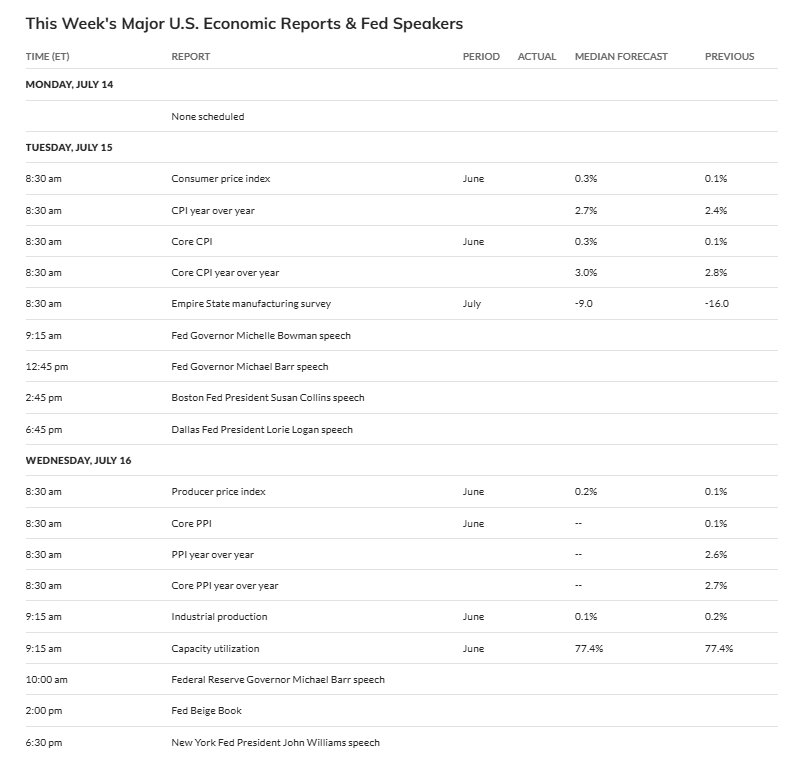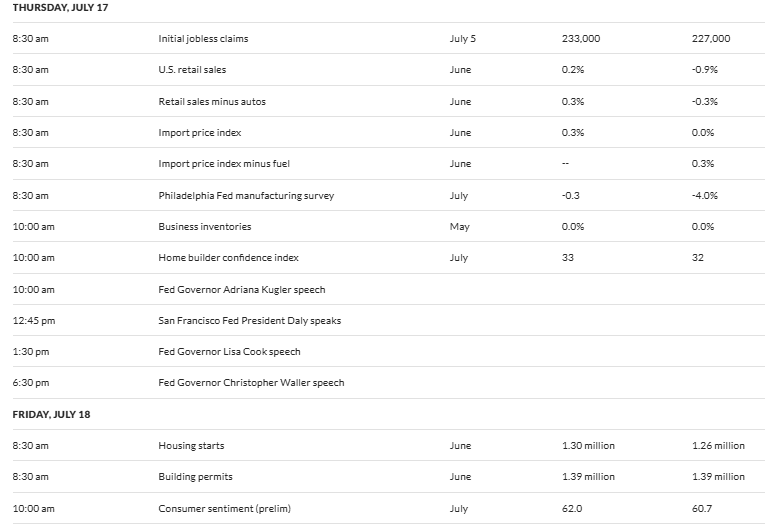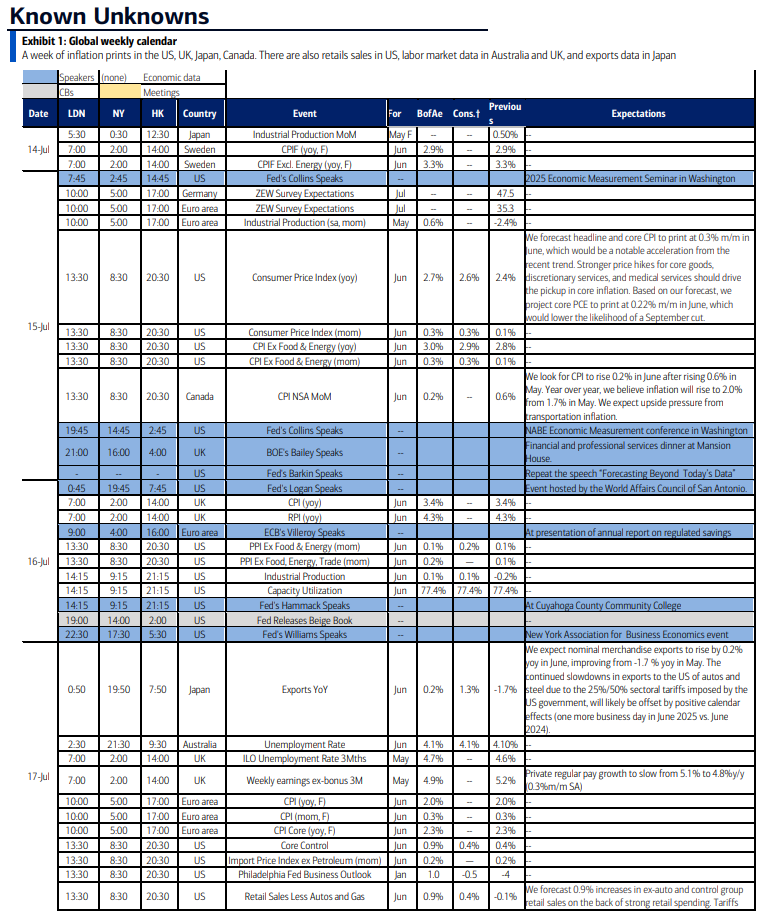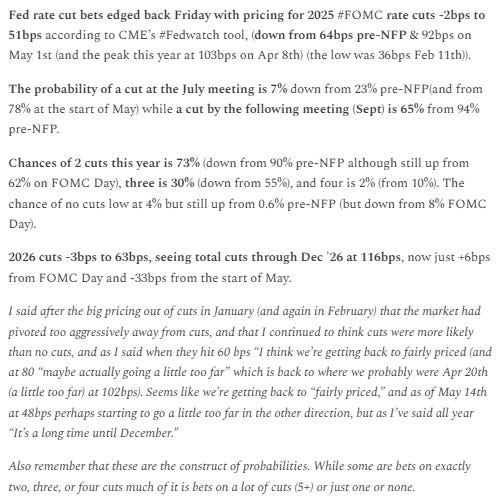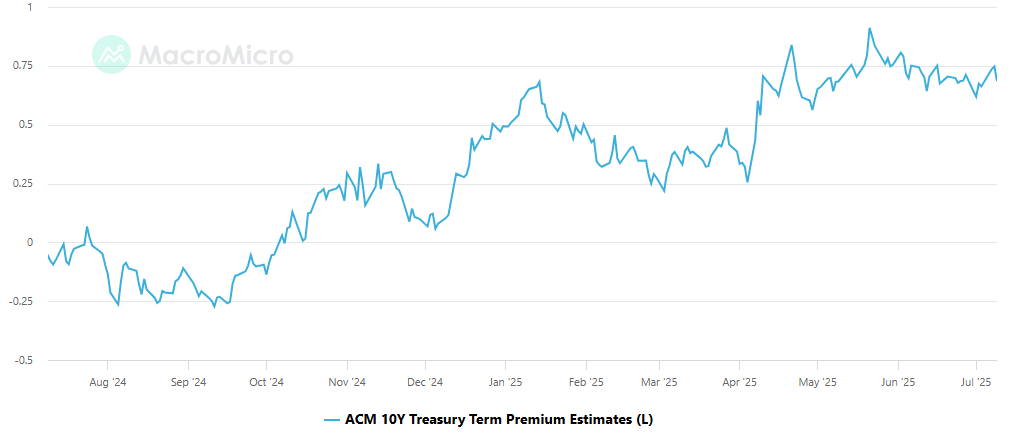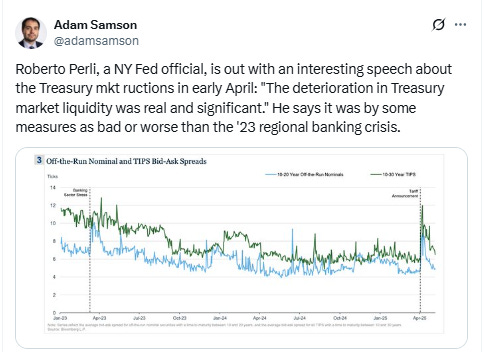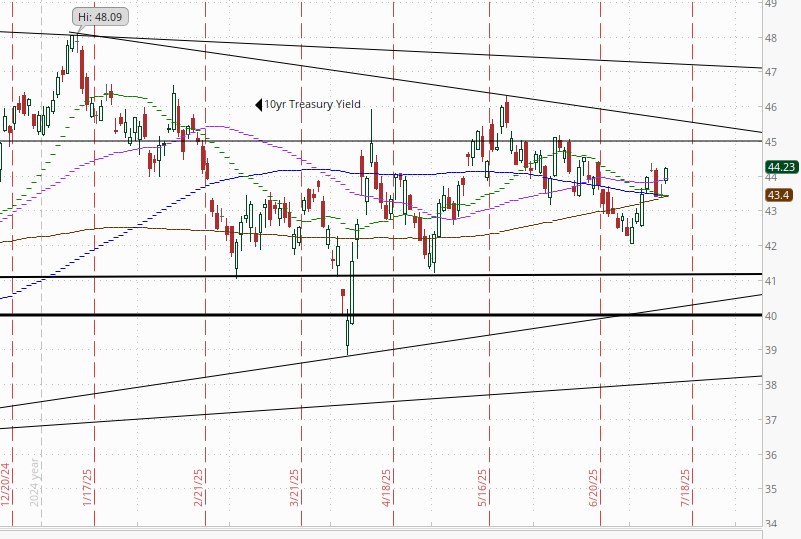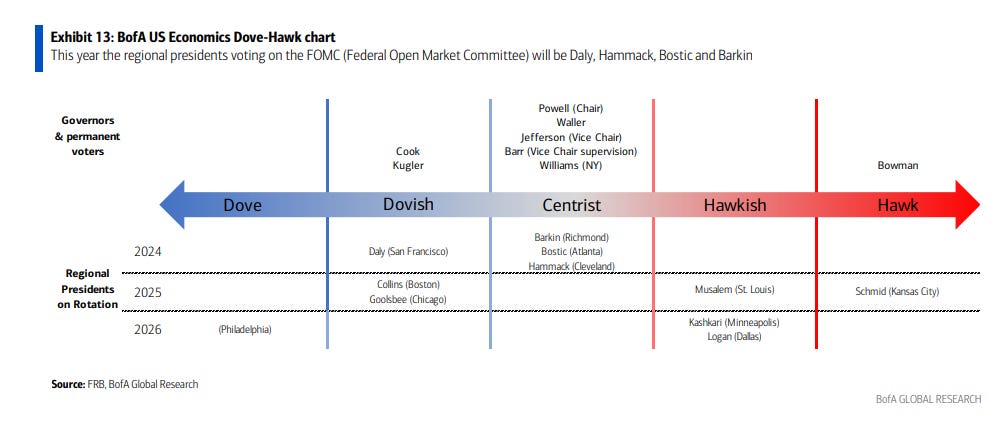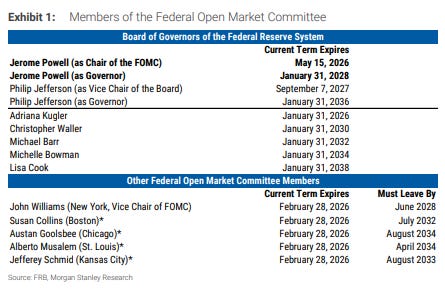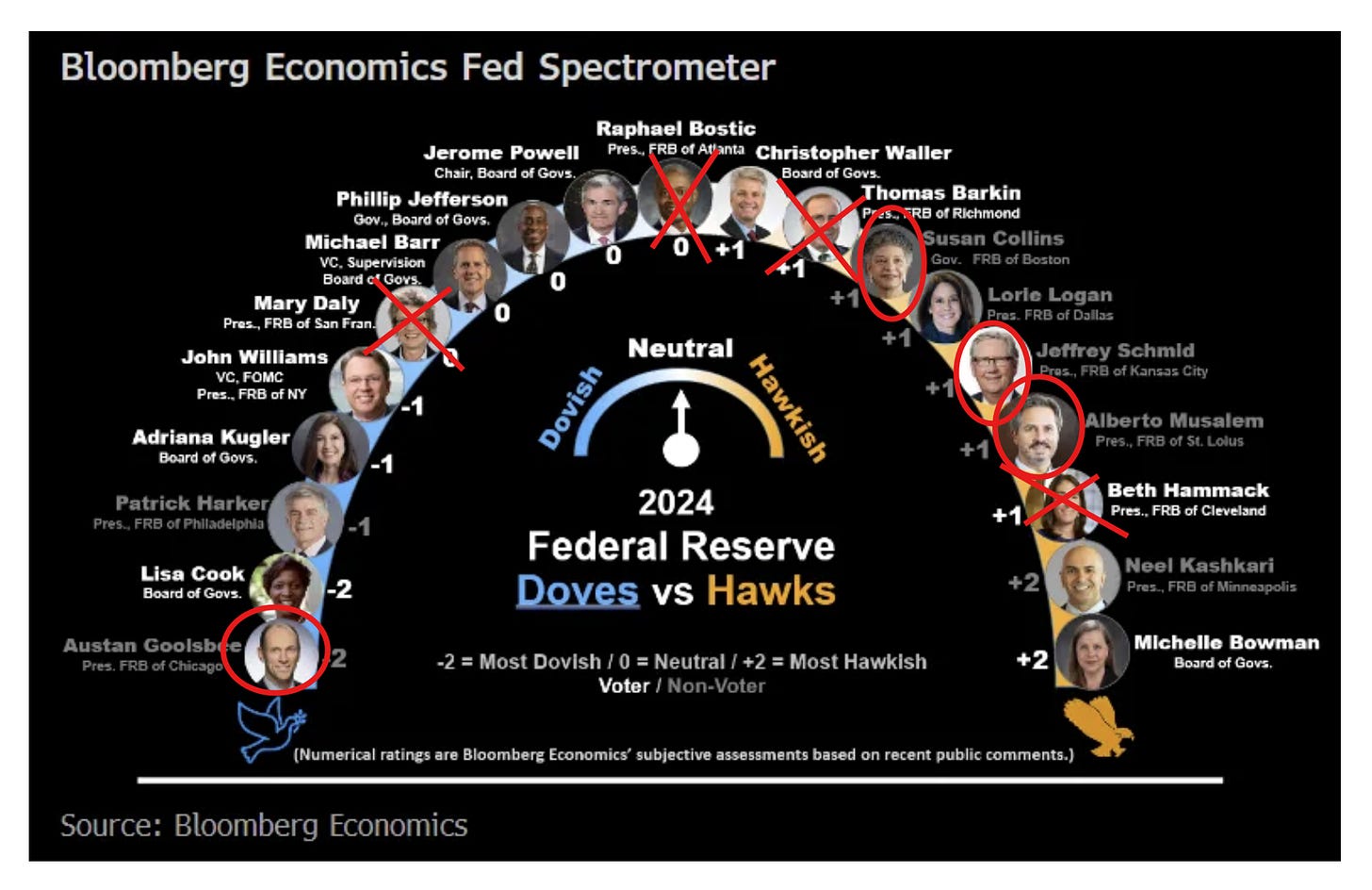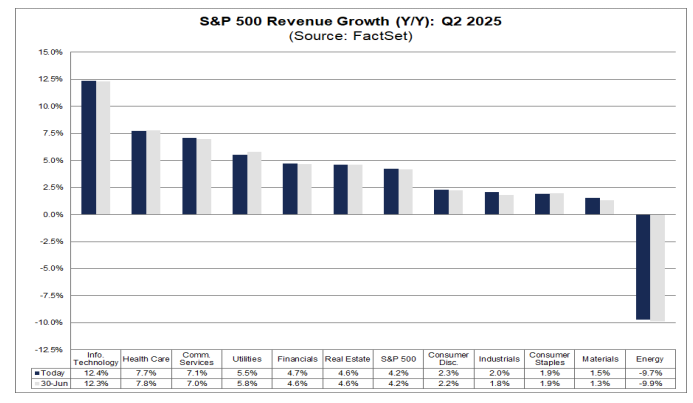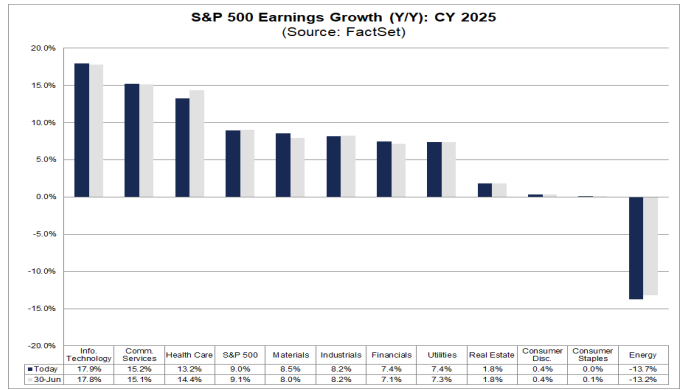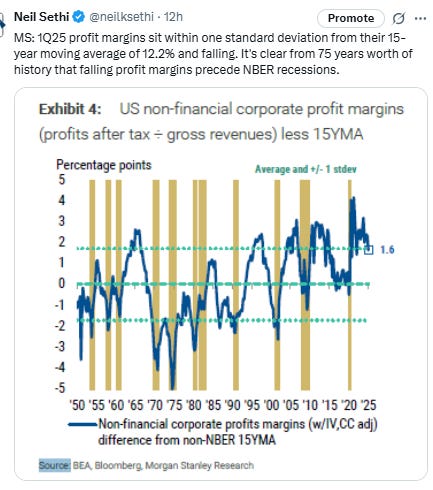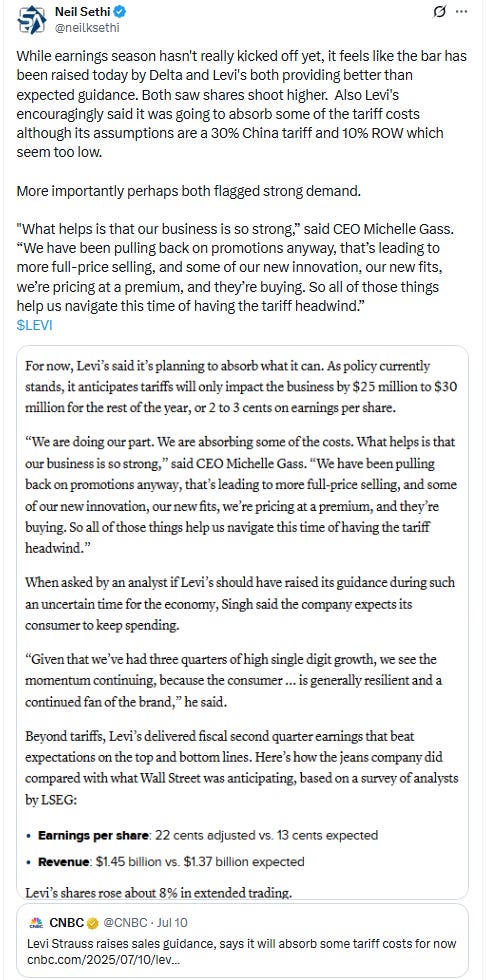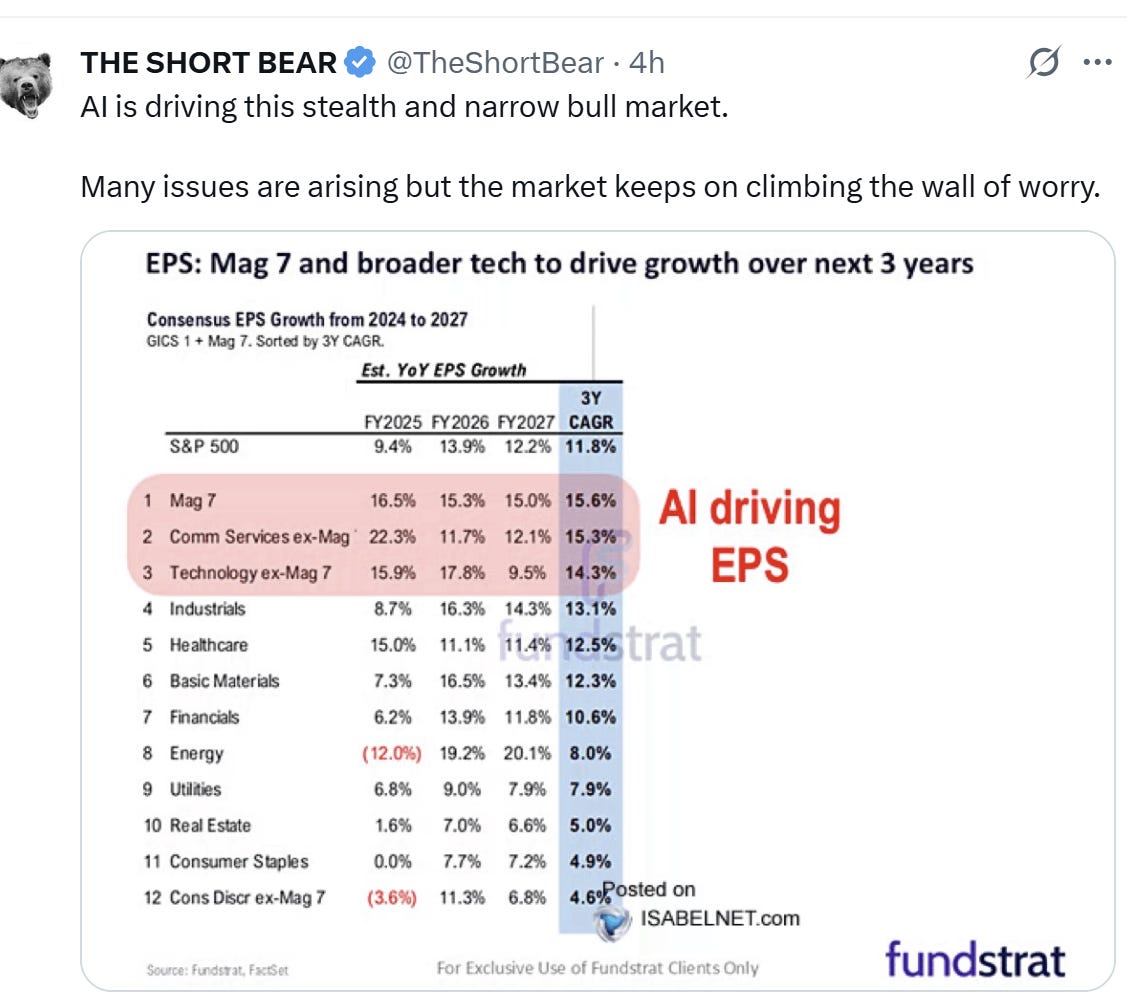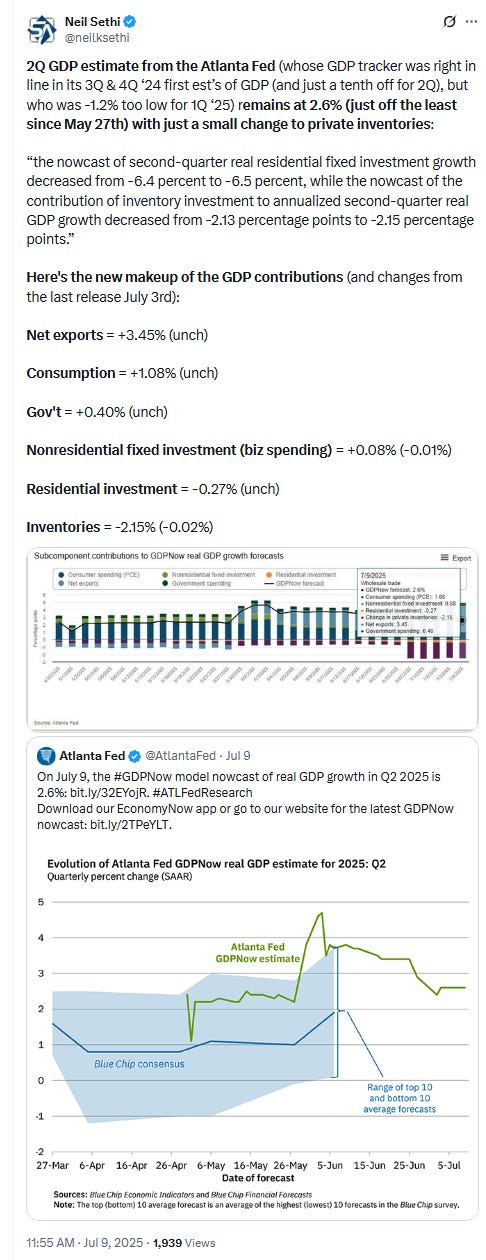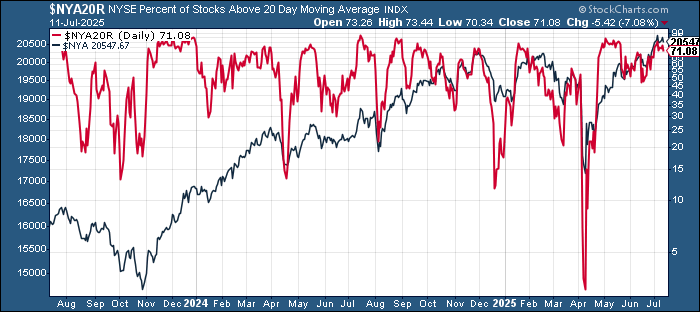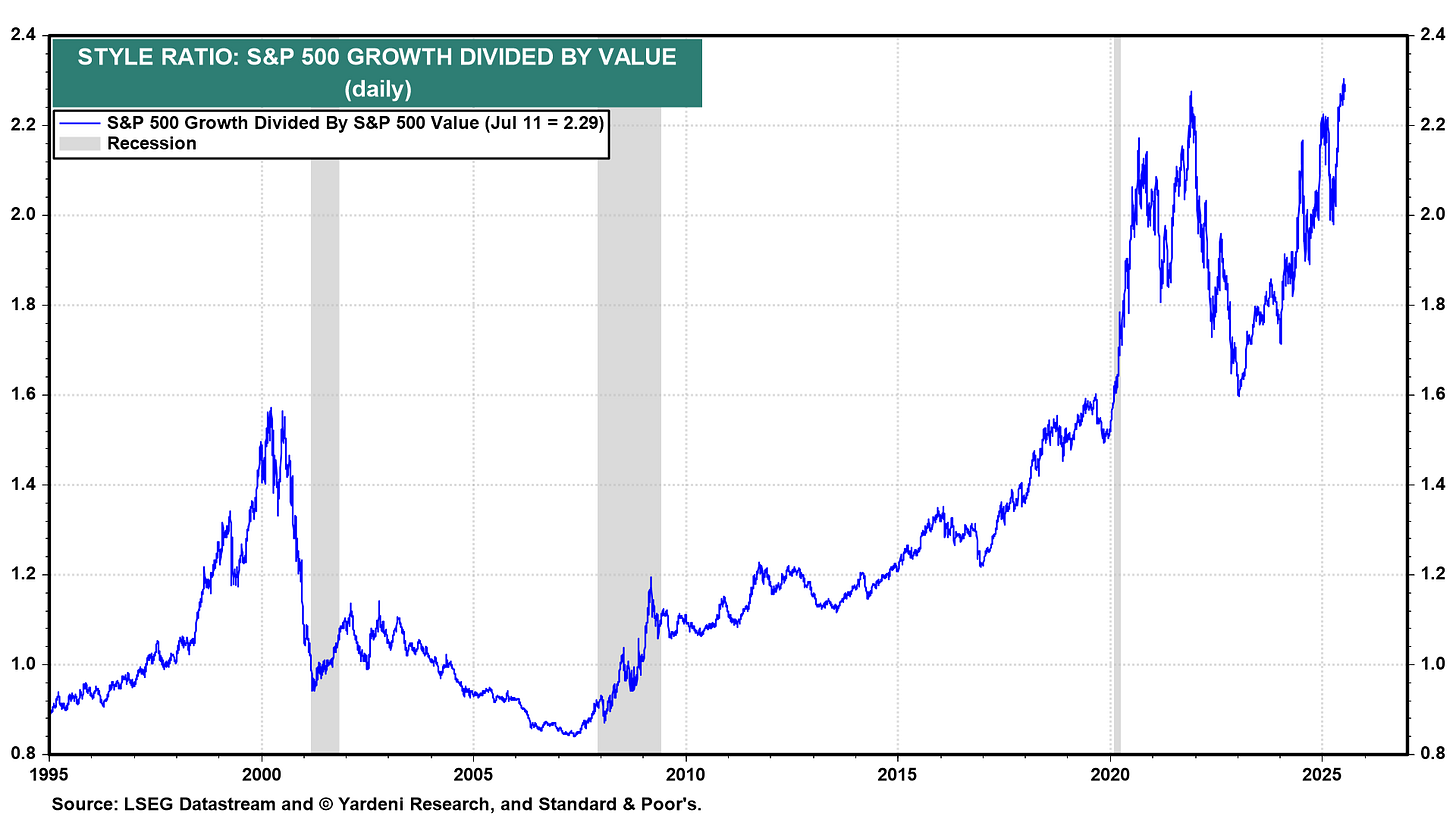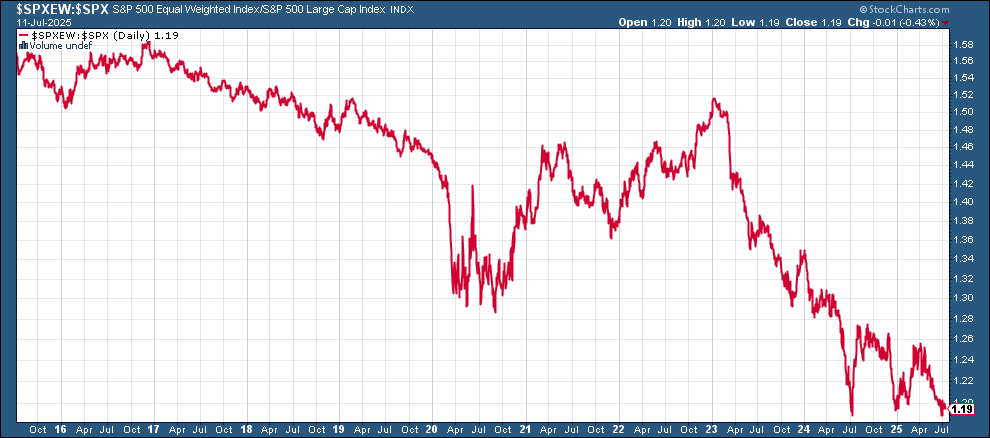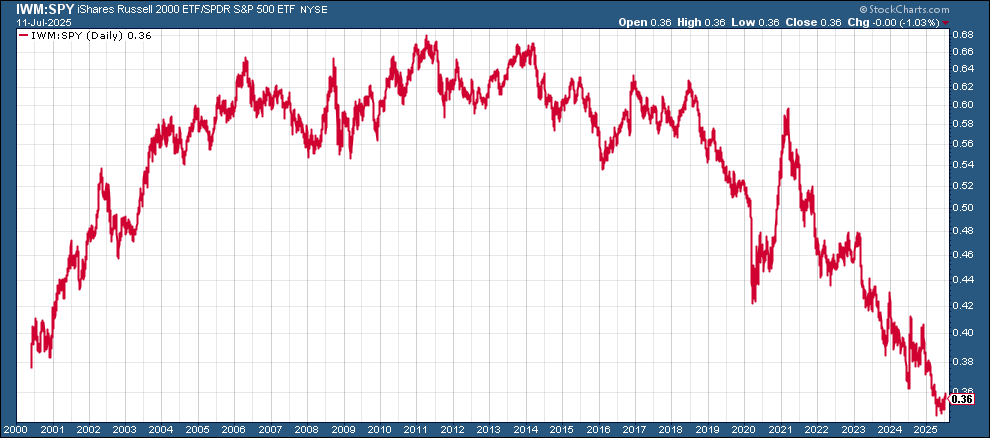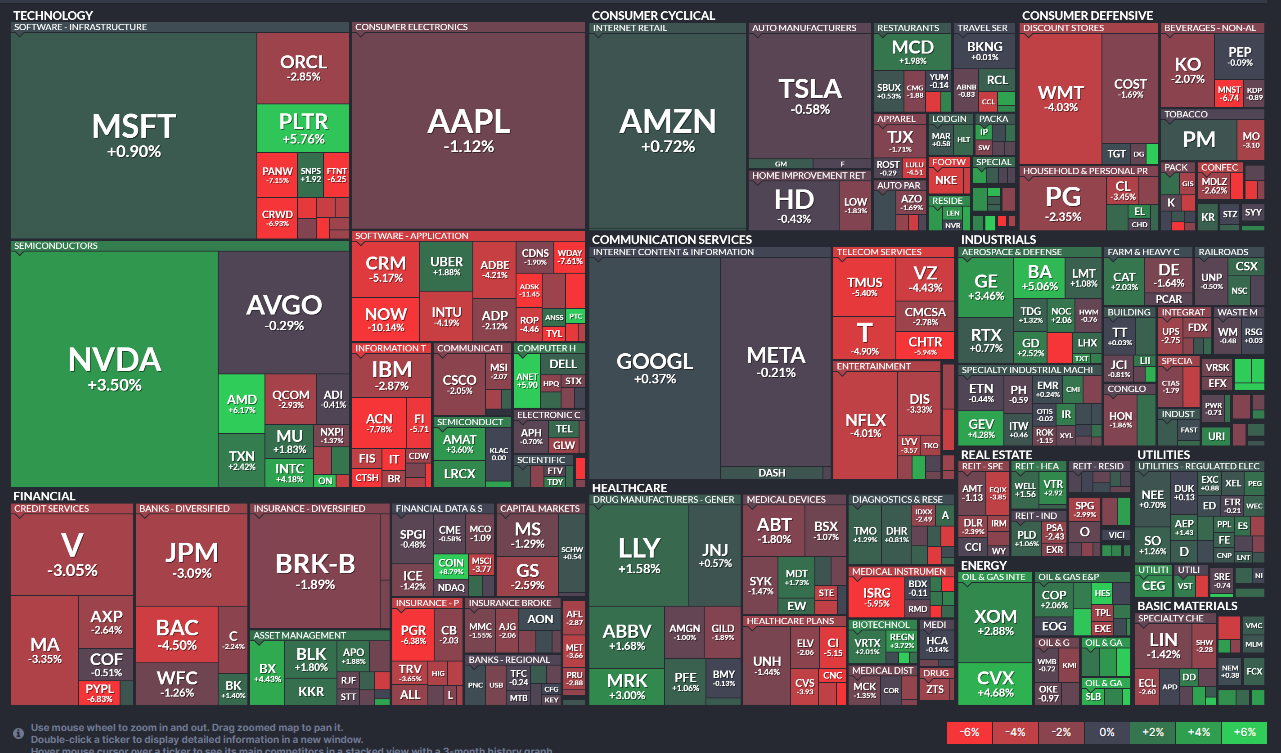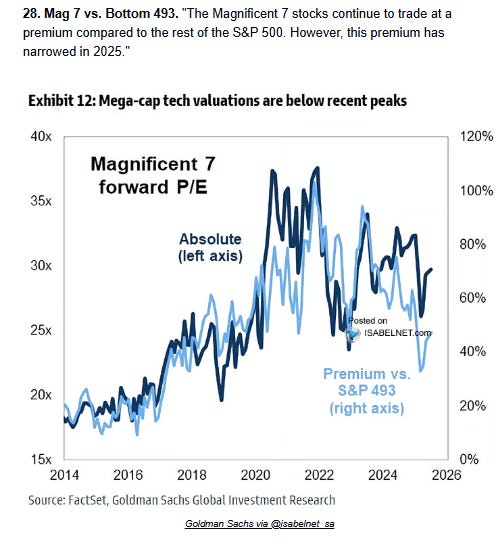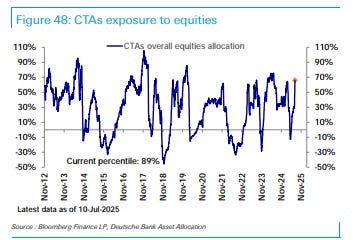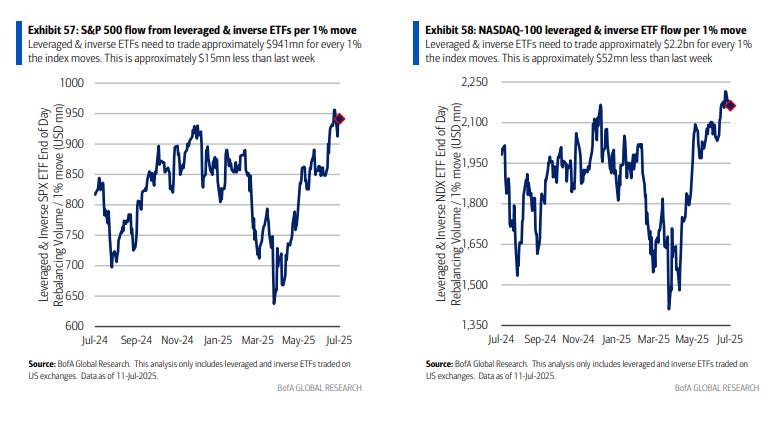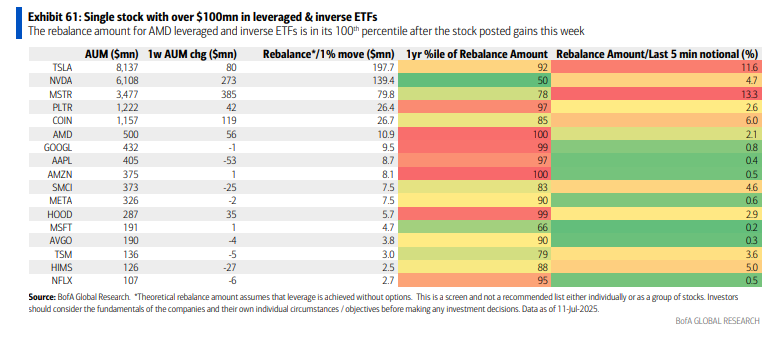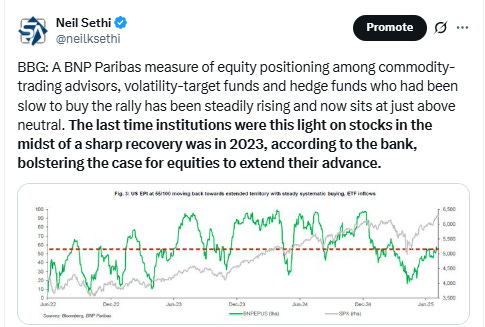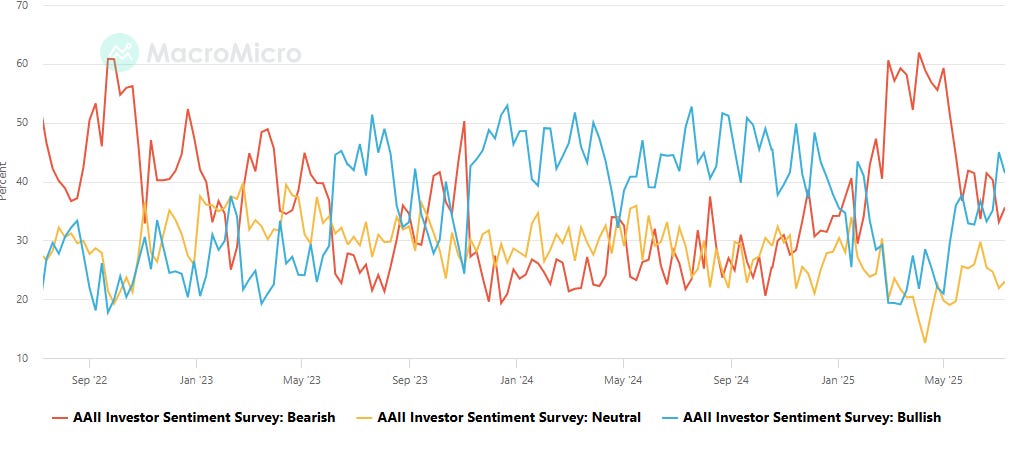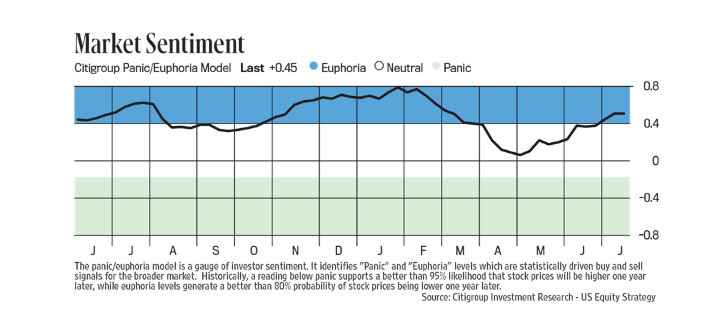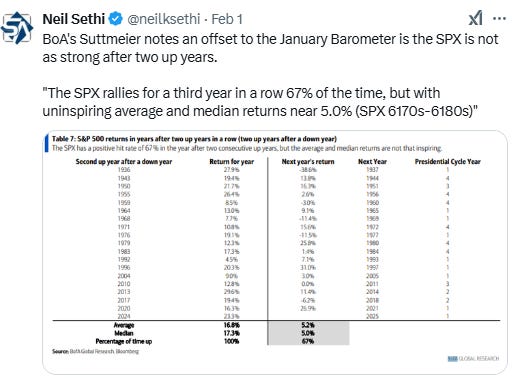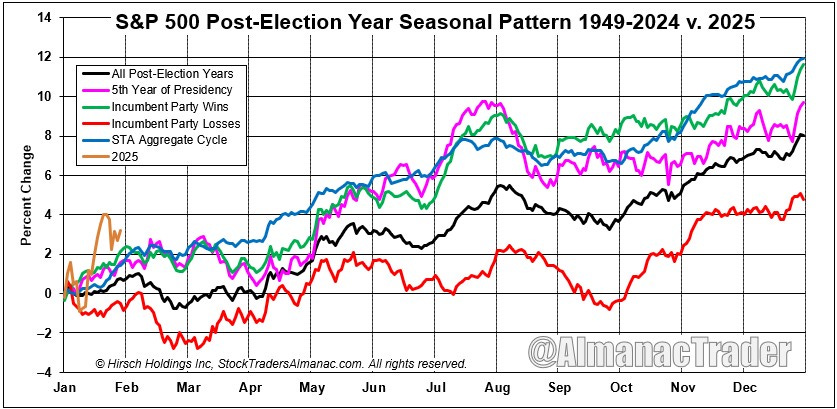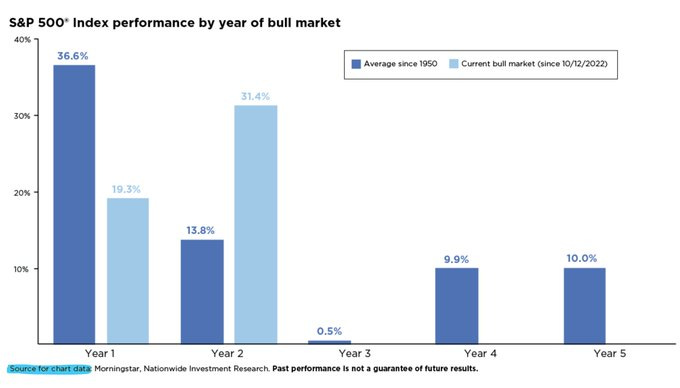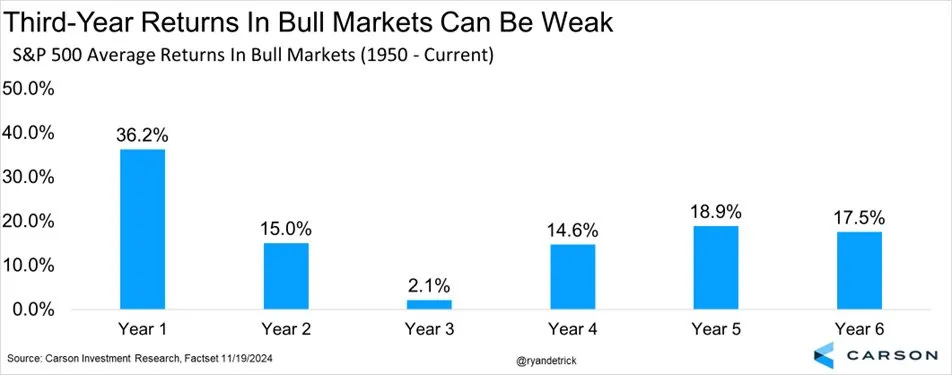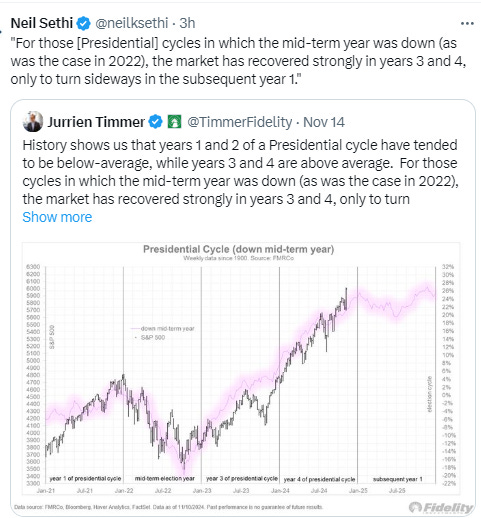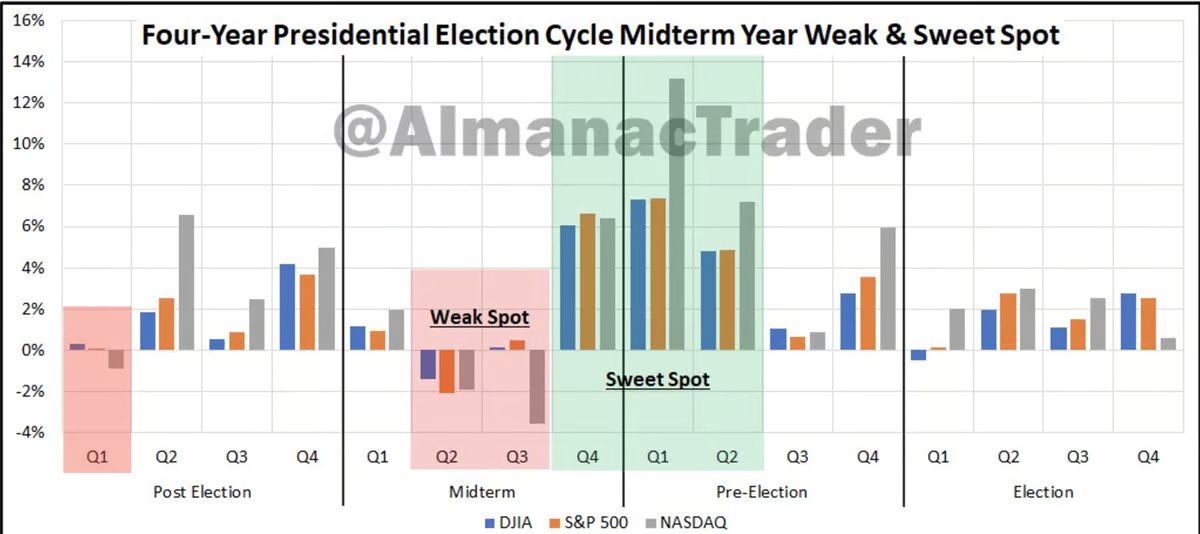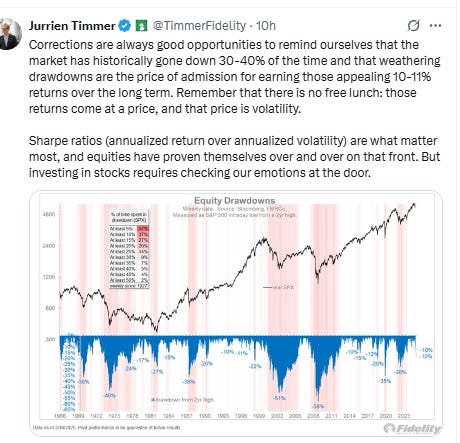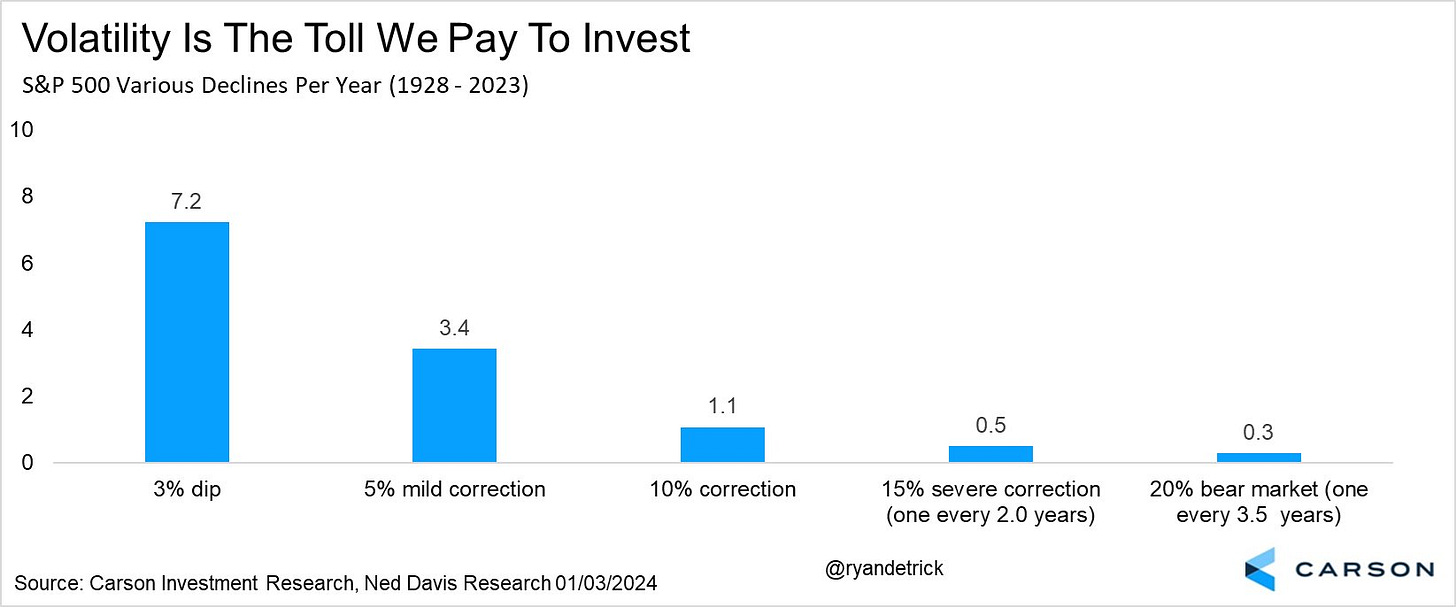The Week Ahead - 7/13/25
A comprehensive look at the upcoming week for US economics, equities and fixed income
If you're a new reader or maybe one who doesn’t make it to the end feel free to take a second to subscribe now. It’s free!
Or please take a moment to invite others who might be interested to check it out.
Also please note that I do often add to or tweak items after first publishing, so it’s always safest to read it from the website where it will have any updates.
As a reminder, some things I leave in from prior weeks for reference purposes, because it’s in-between updates, it provides background information, etc.. Anything not updated this week is in italics. As always apologize for typos, errors, etc., as there’s a lot here, and I don’t really have time to do a thorough double-check.
For new subscribers, this is a relatively long post. The intent is to cover the same areas each week. Sometimes the various areas are more interesting, sometimes less, but it’s easier just to go through them all, so you can expect this format (with things in the same places) each week.
The main sections are intended to cover 1) what’s upcoming next week, 2) what the Fed and rates are up to, 3) what’s going on with earnings (which along with valuations are the most important determinants to stock prices over the long term), 4) what’s going on with the economy (both because of its impact on our daily lives (I am a business investor in my “real” job) but also because it impacts earnings), 5) valuations, 6) breadth (which gets into sector/style performance), 7) positioning/flows (this is the most important determinant to asset price changes in the short term), 8) sentiment (really only matters at extremes though), 9) seasonality (gives you an idea of what normally happens), 10) “Final Thoughts” (remember you get what you pay for there, and it’s the last thing I do so it often is a bit rushed), and 11) my portfolio (to be transparent about where my money is in the market (but note first it is most definitely not intended as financial advice, and second as I mentioned earlier my main job (and investing assets) are in private industries (RE & venture capital)) so my portfolio is built with that in mind (i.e., it’s not how I pay the day-to-day bills)).
The Week Ahead
After what was a rather light week all things considered, things turn up a notch on many fronts in the upcoming week.
Starting with US economic data, as noted last week, all of big second and third week reports were rolled into the upcoming week for whatever reason. So in addition to the standard inflation reports (June CPI (which is expected to see core reaccelerate to the highest m/m since Feb), PPI (which, along with CPI, will give us a very good read on what PCE prices will be at the end of the month), and import prices (Tues, Wed & Thurs)), we’ll also be getting the normal third week reports highlighted by retail sales but also including industrial production, housing starts/permits, NAHB homebuilder confidence, and preliminary July UMich consumer confidence in addition to the standard weekly reports (jobless claims, mortgage applications, and petroleum and nat gas inventories). Note the unemployment claims data this week corresponds to the survey week for the July NFP.
We’ll also get the Fed Beige Book this week ahead of the July FOMC meeting at the end of the month, and a lot more Fed speakers as this is the last week before the blackout. In terms of Fed Governors (generally considered more influential with 14-yr terms who vote every year) on the calendar, we’ll get Bowman, Barr (twice), Kugler, Cook, and Waller. In terms of regional Fed Presidents (who serve 5-yr terms (up to 10 yrs) and vote on a rotating schedule (except the NY Fed Pres (Williams) who votes every year) we do get Williams (who will be making an outlook speech on Wednesday which could give some clues as to how the center of the Fed is looking at things), Collins, Logan, Barkin (twice), Hammack, and Daly, and there are always more not on the calendar. So we’ll have a very good idea on where things stand heading into the blackout.
No Treasury note/bond auctions at least.
But we’ll get the unofficial kickoff to 2Q earnings season with JP Morgan on Tuesday. In total we’ll get 42 SPX reporters this week, including 17 >$100bn in market cap (in order JPM, NFLX, JNJ, BAC, GE, WFC, ABT, MS, AXP, GS, PEP, BLK, SCHW, C, PGR, MMC, PLD). As a side note, I didn’t realize that C had fallen so far down the list of the biggest financials.
So, a lot going on, and that doesn’t include what seem to be a never-ending stream of headlines out of Washington.
Ex-US a little busier week highlighted by a G-20 meeting in South Africa (although the US is not sending any top-tier delegates), UK Mansion House speeches from Chancellor Rachel Reeves and Bank of England Governor Andrew Bailey, UK, Japan and Canada inflation data, EU and Japan industrial production, Germany’s ZEW investor confidence, China trade figures along with the monthly “data dump” of retail sales, industrial production, fixed asset investment, home sales, unemployment, etc., GDP from Brazil, Peru, and Columbia policy decisions from Indonesia among others.
Canada
Statistics Canada will release the second of two inflation reports before the Bank of Canada’s rate decision on July 30. The central bank is closely watching core measures, which have accelerated in recent months but cooled slightly to 3% in May.
Asia
A slew of data from Japan and China will be the focus, with key growth and trade indicators from Malaysia to India also in the spotlight. It begins Monday, when China releases trade figures which will give the latest read of the impacts of US tariffs and potential frontloading of shipments. The next day, numbers for China’s June new home sales, retail sales and unemployment provide a snapshot of consumers, while second-quarter gross domestic product is forecast at a slower 5.3%, and industrial production figures are set to show the overall health of the economy and a key driver of it.
In Japan, core machine orders and final May industrial production figures are out Monday and are expected to underscore a slowdown in activity. Thursday’s trade data is expected to also be weak. Inflation figures on Friday will highlight the challenge facing Japan’s central bank, with national consumer price data for June set to show the headline rate slipping to 3.3%.
Growth and trade will be key themes across the region. India reports exports for June on Tuesday, while inflation is seen cooling in data out Monday. Malaysia releases second quarter GDP figures and export data after a weak May. Singapore likely notched a 0.8% pace of growth in the second quarter, while South Korea’s export and import trade price weakness may continue into June amid weaker demand. Elsewhere, Indonesia’s central bank is expected to cut its key interest rate.
Europe, Middle East, Africa
The week’s regional highlight will be the gathering of finance ministers and central bank governors from the Group of 20, the second such meeting since South Africa took over the rotating presidency from Brazil. The event will again be overshadowed by US tariff threats and the absence of Treasury Secretary Scott Bessent. The world’s largest economy has expressed displeasure with the host’s theme of “Solidarity, Equality and Sustainability,” as well as some of its foreign policies.
Meanwhile, the UK will remain in the focus for markets amid heightened concern about its public finances and after a poor growth number for May, released on Friday. On Tuesday, Mansion House speeches by Chancellor Rachel Reeves and Bank of England Governor Andrew Bailey will draw attention. Inflation data for June is released the following day, with economists predicting an outcome stubbornly stuck above 3% for the headline measure, and the services gauge weakening only slightly, to 4.6%. Policymakers may take more reassurance from labor-market numbers on Thursday, which are set to show pay pressures weakening noticeably.
In the euro area, industrial production on Tuesday, along with Germany’s ZEW index of investor confidence, will be among the highlights. Export numbers from the region will be published the following day, with Switzerland’s data due on Thursday. Each may reveal disruption to trade from US President Donald Trump’s tariffs. Aside from the G-20 meeting, few appearances by European Central Bank policymakers are on the schedule. The governors of Croatia and France will be among those speaking.
In Israel on Tuesday, data will probably show that inflation remained steady at 3.1% last month, according to a Bloomberg survey of economists. That’s still above the country’s official target of 1% to 3%, and may ensure the central bank remains cautious about easing. In the Democratic Republic of Congo, the central bank may lower borrowing costs for the first time since 2022 as its inflation-adjusted interest rate — at 14.5% — is one of the highest in the world. Angola on Friday will probably keep its benchmark at 19.5% for a seventh time in a row. Officials will want to assess the impact on inflation of an increase in public-transport fares by as much as 50% after the government raised diesel prices earlier in the month.
Latin America
Brazil on Monday reports May output data that’s likely to show further month-on-month slowing as interest rates near a two-decade high drag on Latin America’s No. 1 economy. A 16th straight quarterly expansion looks to be well within reach, but if Trump makes good on his threatened 50% tariffs, a second-half recession isn’t out of the question.
Two of the region’s other big economies — Peru and Colombia — also post economic activity reports. Both were largely spared a direct hit from Trump’s most recent escalation of tariff tensions. While Peru is a major exporter of copper, 50% levies on the metal at the US end may do little to dampen demand, since copper plays such a central role in industry and the production of consumer goods. Rounding out June price readings for Latin America’s big economies, Argentina will all but certainly post a 14th straight month of slower annual inflation, quite likely sinking below 40%. After monthly consumer price increases decelerated to 1.5% in May, most analysts expect an uptick in June. The median estimate of economists surveyed by the central bank peg the monthly print at 1.8%.
BoA cheat sheets for this week.
Day-by-day calendar from DB (not posted yet):
And here’s calendars of 2025 major central bank meetings.
Market Drivers
So let’s go through the list of items that I think are most important to the direction of equity markets:
Fed/Bonds
As noted previously this was one of the sections that had grown unwieldy, so I’ve really pared it down. Given I provide daily updates on Fed expectations, Fedspeak, and analyst thoughts on the Fed, it’s duplicative (and time consuming) to regather it all, so, again, I encourage you to look at those (the daily posts) for updates. I will just give more of a quick summary.
I’ve taken out the background information from how we got to where we were from the start of the year through the end of March, but if you’re interested you can find that in this section from the March 23rd update.
As I had been noting the month or so leading up to the June Fed meeting,
there have been some differences in how Fed members are looking forward, particularly into the second half. While many think there’s a low probability for rate cuts this year absent a serious deterioration in the labor market (regional Fed Presidents Schmid and Musalem have even talked about “leaning against” potential inflation consequences (i.e., putting rate hikes on the table (although Schmid was not so aggressive in his last appearance)) or perhaps a chance for one (Bostic), others are more constructive led by Governor Waller. Mary Daly continues to think two cuts are a “base case,” while Goolsbee is back looking for “much lower rates” in 10-16 months.
Another place there is some difference is in how Fed members think they should respond to a situation where inflation is sticky or increasing while the labor market is weak. As noted Schmid and Musalem, joined recently by Dallas Fed President Logan (not a voter this year) and Gov Kugler (who provided a very detailed analysis of her thinking (see the Friday update) would not be cutting, and NY Fed President Williams, a key voice, insinuated recently that in the event of a tradeoff between the Fed’s inflation and growth goals, they should pick fighting inflation.
So as I said 8 weeks ago,
it seems for now the markets probably have it right that the Fed is going to wait until we get deeper into the year and some of the “uncertainty” has hopefully passed (or at least we’ve had a longer run of time with tariffs in place) regardless of what happens with inflation (i.e., they are going to “look through” any cool prints for now). They also will look through high prints focusing on market-based measures of long term inflation expectations. The only thing it seems that would get them to move would be a deterioration in the labor markets.
But I noted 5 weeks ago:
I have a feeling if inflation continues to remain relatively subdued (it was basically at the 2% target in April (so Powell did get his “soft landing”)) that more members will climb on board. That said, there is certainly no rate cut coming at the meeting next week, and given we’ll only get one more set of inflation and NFP reports by July, it seems the market may be correct in September being the most likely next cut.
And as noted two weeks ago:
we did see more members “climb on board” with Waller, most notably Michelle Bowman, although that was as much her “throwing her hat in the ring” as a potential Fed chair. And while Daly and Goolsbee continued their constructive tones seeing two rate cuts this year (and Kashkari (who is not a voter this year) did the same, a large contingent came out more hawkish led by Powell, although outside of the very hawkish wing (basically Schmid and Hammack who are clearly in the no cuts this year camp and perhaps Musalem) there has been a softening in the tone as Fed members “mark to market” their statements (i.e., inflation at least at the consumer level has remained tame).
I thought Powell did a better job this week (than at the June FOMC where I was critical of his performance) in his Congressional testimony in being more balanced and acknowledging that there was certainly a path where tariffs result in moderate and/or “one time” price rises that would clear the way for rate cuts later this year. In that regard he said that with all of the uncertainty, he thought “any of” the potential inflation paths that were being forecasted by Fed members were reasonable. Importantly, both Powell as well as other Fed members say they are expecting to see tariff impacts “in the summer” and Powell specifically pointed to the June and July inflation reports (to be delivered in July and August) as key inputs.
Given all of that, I think it’s now pretty clear that if we get through August with no notable tariff impacts that the Fed will be cutting in September and likely again in December (and maybe also October if the economy starts softening) assuming things continue towards the 2% target. Of course, we could always see a quicker start to the cutting cycle if we see a sharp rise in unemployment (I think above 4.5% or 4.6%) or growth really starts to deteriorate. There even remains the outlier possibility that if we get a weak employment report (and other economic data) over the next several weeks and still soft inflation we could see July become “in play”.
As I noted last week though “I think it’s fairly safe to say if the FOMC does anything [at the July meeting], it would be to “tee up” a potential Sept cut if inflation remains tame than to move this month. You never know of course, but if a cut is coming this month, it will without a doubt be messaged ahead of time via one of the ‘Fed Whisperers’. We’ll be getting a lot of data between July and September, and I think it’s safe to say that if it continues to come in consistent with readings the past few months, a cut is coming in September.”
And all of that remains doubly true now that Trump has extended the tariff uncertainty to the end of the month (even now Goolsbee is back to being cautious about cuts with all of the “dirt in the air” from the most recent tariff dust up.
And that’s consistent with what we saw in FOMC pricing as of Friday:
And with yields continuing to trend in the same ranges over the past few months, the 2/10 curve has as well remaining around the +0.5% area.
As a reminder, historically when the 2/10 curve uninverts following a long period of inversion the economy is either in a recession or within a few months of one. It uninverted in Sept, so I had said this looks officially like a "this time is different" situation.
The 3mos/10yr yield curve (considered a better recession signal than 2/10’s w/the last four recessions on average coming a few months after the curve uninverted (prior to that it generally uninverted after a recession had already started)) like the 2/10 curve has trended sideways the past few months but in its case around the unchanged mark, still clearly calling for rate cuts (this is normally closer to 1.25%).
As noted back in February, this (reinverting) is something that it did prior to (or just after) the last two recessions and it also dipped (but didn’t reinvert) in the two recessions prior to that. Not sure if the reinversion “restarts the clock” on the recession watch. If so the longest it went in those previous four instances before recession after reinverting is 6 months (2007).
Also note that in 1989 and 2007 we saw similar periods of a recovery from inversion that stalled at the zero line for long periods of time which turned into recessions after they lifted (but in 1989 it took six months).
And another way of looking at this, the 10yr Treasury yield continues to fluctuate around the Fed Funds rate, well under the typical spread of around 1-1.25% above, so also for now still calling for rate cuts.
As noted previously when it’s dropped from above to below (as opposed to having the FFR move from below to above) as it did earlier this year, we’ve always seen a rate cut since 1985 although it can take as long as a year.
Long term inflation expectations as measured by the 5-yr, 5-yr forward rate (exp'd inflation starting in 5 yrs over the following 5 yrs), which continues to be referenced by Fed members (including Jerome Powell (although I don't think he mentioned it at the June meeting)) as evidence for long-term inflation expectations remaining “well anchored,” did hit 2.34% this week, the highest since January before settling back, overall remaining around the middle of its 4-year range, so for now not showing a great deal of concern about longer term inflation pressures (it’s right around its 20-yr average).
And the 10-yr breakeven rate remains in the middle of its post-2021 range at 2.37%, +3bps w/w but also the highest since March.
10yr real rates remained around 2% this week, below the 2.34% mid-Jan peak (which was the highest since Oct ‘23 (and before that 2007)), well above the 2012-2020 peak of 1.12%.
As with 10yr rates implied from market pricing, backing into 10yr real rates using 5-yr, 5-yr forward inflation expectations (subtracted from the 10yr nominal yield) similarly saw them similarly around 2% (a little above as this series has consistently been a bit higher) still well below the Jan peak (2.45%). These though remain over four times the 2013-2020 average of around 0.5%.
And as a reminder according to BoA the importance of real rates on equity returns has seen the largest increase in the factors they track over the past 5 yrs and explains a larger proportion of stock returns (83% correlation) in their data (to 2006), with the dollar close behind the most correlated (76%) since 2015.
Short-term real yields (Fed Funds - core PCE) fell back to 1.65% in May from 1.75% in Apr (rev’d from 1.81%) which was the highest since October, remaining well under the 2.70% last June, which was the highest since 2007, but above the local low of 1.38% in February. [this gets updated at the end of the month].
Not much relief for small businesses or HELOC borrowers as the real prime rate (inflation adjusted using core PCE) fell just a tenth to 4.82% from 4.92% in Apr although over a percent below the 5.9% high last June, which was the highest since Sep 2007. Still, it remains more than double the 10yr pre-pandemic avg. [this gets updated at the end of the month].
A little surprising to some was the FOMC’s median long run projection for the endpoint of the Fed Funds rate (the “neutral rate”) remaining at 3.0%. That said, note the average moved up to 3.11% from 3.02%, and even at 3% it is the highest since Sep 2018 (but also well below levels prior to that). [this will be updated after the July FOMC].
The ACM model of the 10yr UST term premium (which is solely based on interest rates), edged up w/w for the first time since May to +0.69% (+5bps w/w) but overall in the range since April. The peak this year was +0.91% on May 21st which was the highest since July 2014.
The extended discussion on term premium (what it is, why it’s important, etc.), can be found in this section in the Feb 4th Week Ahead.
The MOVE index of expected 30-day Treasury note/bond volatility hit the lowest since Jan ‘22 this week before settling a touch higher.
With overall Treasury volatility falling, 30yr mortgage spreads did as well but remained above the lows of the year at 2.34% in the 2.5-2.3% range since last September, well under the 2024 peak of 2.73% and the 37-yr high of 3.1% in June ‘23. But they are still around +60bps above the 2010-2020 avg level.
Chicago Fed National Financial Conditions Index and its adjusted counterpart (the latter attempts to remove the correlation between the various indicators due to broad changes in economic conditions), both of which are very comprehensive, each w/105 indicators, in the week through July 4th both edged to the least (loosest) since Feb.
https://www.chicagofed.org/research/data/nfci/current-data
And Goldman’s FCI is at the lows of the year.
Turning to RRP, some background:
As the Fed continues to drain liquidity from the system via QT, I think it’s important to watch for stresses which give an early warning signal that they are perhaps going to far as they did in 2018 which led to a near bear market. One area I am monitoring is reverse repos (which is an overnight secured place institutions (mostly money markets and banks) can park excess funds to accrue some interest, designed by the Fed originally to keep excess liquidity from pulling down rates too much in other short term markets and provide a “risk free” place to park short-term funds). RRP grew rapidly in 2021 & 2022 as money was pumped into the system and needed a home, but since May ‘23 has been steadily drained down by the Fed’s QT program and higher bond issuance with banks discouraged by regulatory rules from taking up the increased Treasury supply.
In particular, the continued sizeable issuance of T-bills (<1 yr duration) of around $800bn/month (accentuated by the $60bn in balance sheet runoff (meaning the Fed has reduced its buying of maturing Treasuries by that amount which the private market has to fill)) drained ~$1.75 trillion from RRP in the year through March 1st. From then until early July RRP levels had remained relatively stable in the $375-$500bn range, but then resumed their decline (in fits and starts (seeing spikes at most month-ends but then coming down to hit new lows), with the lowest level hit Feb 14th at $58bn, the least since Apr ‘21 on the back of the Fed cutting RRP rates to the low end of the Fed Funds band which made parking funds there (versus lending overnight to other institutions or buying T-Bills) less attractive in line with their desire to sop up most of this “excess liquidity” (as they have described it).
As noted in previous weeks, since then RRP had rebuilt as with the Treasury up against the debt ceiling they have had to stop issuing new Treasuries only refinancing maturing ones, which had taken away a source of investment for money markets and other buyers who have had to turn to the RRP in part despite the lower rates. With the debt ceiling now raised, and with the administration apparently looking to increase T-Bill issuance this is an area that will need monitoring, although some on the Fed think this can be drained to zero without any collateral damage.
As noted last week, with the debt ceiling raised, the Treasury is in the process of refilling the TGA (Treasury bank account) which was drawn down as they could not issue above the previous limit, which will mean around $400-500bn in extra T-Bill issuance over the next couple of months, as it did in 2023 when we faced a similar situation.
Markets had no issues in 2023, but in part that was from RRP funding around $800bn of the rebuild. That said, things are different today. QT has been slashed, deficits were increasing (they have declined slightly due to the tariff revenues this time around), and we now have the current need of stablecoins for T-Bills, all of which may be enough to absorb the extra issuance. So, I’ll be watching RRP levels (and more importantly bank reserves discussed below) as an early indicator of potential liquidity issues.
This week, though, all is well with RRP at $180bn a very comfortable number.
In that regard, here is what BoA said earlier this year:
We expect a debt limit resolution in late July/August, which would imply a large TGA rebuild from near $0 following the resolution.... At that time we expect the Fed’s 'dashboard' of money market & liquidity indicators will clearly shift from green, past yellow, and towards red. We continue to believe UST repo is the single best indicator for flagging when QT should end."
RRP is to me most important in its shielding of bank reserves. The $3tn mark has clearly been a line in the sand, catalyzing the indigestion in the credit markets in March ‘23 (SVB, etc.) and April (Robert Perli, head of the SOMA desk of the NY Fed confirmed we did see stresses). For now though, they remain comfortably above at $3.34tn. But with the TGA being rebuilt, I will be watching reserves closely as an early warning signal for potential stresses in funding markets.
For background on various estimates of when reserves will be “too low” see the Feb 4th Week Ahead.
Getting back to rates, I said back in April 2024 that 2-year Treasuries were a good buy at 5%, and as I noted once the Fed started its cutting cycle thereafter the ship has likely sailed on seeing those yields anytime soon (meaning years). In terms of 10yr’s I had advised then grabbing some at 4.7% (which I subsequently sold on the drop under 3.75% as posted here in September) but at the time seemed like something we wouldn’t see anytime soon, but we got back there in January (and I added some as posted here), and it seemed like we might be headed much higher until Treas Sec Bessent noted the administration’s focus on keeping the 10yr yield low (and perhaps more importantly committing to the auction schedule set up by Sec Yellen for the foreseeable future (and perhaps even reducing longer term supply as he has noted in subsequent interviews), which has exerted downward pressure on 10yr yields). I sold that new, small position on the dip under 4% in April, and I have been waiting on us revisiting that 4.7 - 5% area to reload.
Overall though we continue to see range bound action in my “2025 likely trading range of between 4 and 5%.” While they left that range in early April (for one day), other than that we’ve been solidly in it, which I expect to continue for now.
I still believe that if we do get a recession with the unemployment rate rising over 4.5%, job losses in the employer’s payroll survey, and contractions in consumer spending and business investment, then we’re likely to see 3.6% again (and probably lower). In terms of how high they could go, I still have a hard time seeing them sustaining for long above 5%.
For all the old “final hike” and “first cut” materials, you can reference the Feb 4th blog post.
Note BoA’s Dove-Hawk chart (which they acknowledge is badly in need of an update) is missing Hammack in ‘26 (Cleveland and Chicago vote every 2 yrs), but otherwise looks right (in terms of voters (also note that Philadelphia Fed Pres' Harker’s replacement has started (Anna Paulson) who will have a vote in 2026). While little is known about how she views policy, she does come from Chicago which is headed by the more dovish leaning Goolsbee (but she’s been there for two decades).
In terms of the Hawk/Dove spectrum it’s still not that far off although Bowman has joined Waller as the most dovish while Kashkari has turned more dovish as well.
While it doesn’t break them across the Hawk/Dove spectrum, UBS had a nice chart this week that gives you voters this year and next. I hadn’t realized that Kugler’s term as a Gov is already up (surprising as those are long).
And here’s one that goes over current term expirations.
And I came across one from BBG. I think it’s pretty accurate except Kashkari is definitely not that hawkish (he was calling for a December cut in early November):
And here who is rotating off and on for 2025.
Found another FOMC hawk/dove chart to add to my collection. This one from Barclays. Seems pretty accurate except have to wonder how hawkish Hammack really is considering she was talking about a June rate cut right before the blackout. Also, don't think Daly is all that hawkish given she said she was looking for two cuts this year that week as well.
And on Harker’s replacement in July.
Earnings
As a reminder, I have removed most of the background material, which you can get in the Feb 4th blog post. You can reference this post from 12/1/24 for stats on 3Q, this post from 3/9/25 for stats on 4Q, and this post from 6/1/25 for stats on 1Q 25.
As we embark on the unofficial kickoff for Q2 earnings Tuesday, as noted in prior weeks, we’ve seen a larger than normal drawdown in expectations since the start of the quarter (April 1st), now to 4.8% y/y according to Factset from 9.3% as of the start of the quarter, -0.2% w/w. This decline is larger than the 5 & 10-year averages (-3.0% & 3.1%).
While the 8th consecutive quarter of positive earnings, it would also be the least y/y growth since Q4 ‘23.
6 of 11 sectors are expected to report y/y growth (Industrials is expected at -0.1% which will likely mean it also will show growth) led by Comm Services & Tech while Energy leads the 5 decliners.
In terms of revenues, Factset says 4.2% growth is expected for Q2, down from 4.7% to start the quarter, which would be the 19th straight quarter of growth.
10/11 sectors are expected to report growth led by Tech. Energy is the lone decliner.
With the tariff backdrop, profit margins will be a big focus this earnings season. Currently, Factset says expectations are for 12.2% for Q2 (-0.1% w/w), down from 12.7% in Q1 but equal to the 12.2% a year ago and above the 5-year average of 11.7%.
Two sectors are expected to report a year-over-year increase in their net profit margins in Q2 2025 compared to Q2 2024: Communication Services (14.0% vs. 11.6%) and Information Technology (24.9% vs. 24.0%).
While Q2 earnings expectations were cut further last week to +4.8% growth (-4.8% past 14 wks (so cut in half), -8.8% last 24 wks),
-Q3 was unchanged at +7.3% (-4.4%, -8.1%),
-Q4 edged up a tenth to +6.5% (-4.8%, -10.2%).
2025 as a whole a very respectable +9.0% -0.1% w/w (first change in 7 weeks).
With Q2 pulling FY 2025 expectations lower, Factset says they are now the least since the start of their tracking at $263.96 (-$10.30 since Dec 31st). Still they deteriorated by just around a dollar since mid-May.
As a reminder, BoA’s analysis is that this number will change by less than 2% by the end of the year absent a major economic event (GFC, Covid, etc.).
That though still represents a pretty healthy growth rate of +9.0% for 2025 earnings (-0.1% w/w), but that’s also down from 12.6% Dec 31st.
Factset says the -3.6% drop in 2025 earnings expectations in the first six months of the year was larger than the 5 & 10yr avgs (-3.4 & -2.4% respectively).
“At the sector level, ten sectors witnessed a decrease in their bottom-up EPS estimate for CY 2025 from December 31 to June 30, led by the Energy (-17.8%) and Materials (-12.0%) sectors. On the other hand, the Communication Services (+2.6%) sector is the only sector that recorded an increase in its bottom-up EPS estimate for CY 2025 during this period.”
In terms of the earnings growth exp’d for 2025 Factset notes it will be a record, although also notes that there is on average over the past 25 yrs a -6.3% deterioration from where it starts the year ($275.05) w/analysts overestimating in 17 of those yrs (which would equate to $257.72 based on the average deterioration). But it should be noted that average includes 4 outlier years (2001, 2008, 2009 & 2020) where the overestimation was b/w 27-43% due to recessions. Excluding those, the difference is just -1.1% (which would equate to $272.02 (above where we are now)).
As a reminder, though, final earnings for Q2 are very likely going to be materially higher than +5%. Factset notes that on average over the past 1, 5 & 10 yrs companies have beaten earnings expectations by 6.3%, 9.1% & 6.9% respectively resulting in “inflation” to the earnings estimates on average by 4.6%, 8.1% & 5.6% respectively over where they stood as of the start of the quarter (in this case June 30th which was 4.9%). That would mean if we get the average improvement earnings should come in at +9.5%, 13.0%, or 10.5% respectively.
Actual earnings by the end of the quarter have not surpassed expectations at the start of the quarter in only 3 of the past 42 quarters (Q1 ‘20, Q3 ‘22, and Q4 ‘22 are the only exceptions according to Factset).
2025 revenues are now expected to grow +5.0% down -0.8% since Dec 31st, and down from 5.4% at the start of the quarter (April 1st).
Energy is the only sector expected to have negative revenue growth (although that’s been cut by two-thirds since the start of the quarter).
The softening to 2025 earnings expectations (now down to +9.0% y/y growth from over 14% at the start of the year) has been matched by 2026 expectations which have remained near +14% all year (as of Thursday +14.0%, +0.3% since Dec 31st), as they've mostly just tracked 2025 lower keeping the spread the same.
Factset’s analysis of analyst bottom-up SPX price targets for the next 12 months as of Thursday continued to increase for a 7th week (following a 10 week string of decreases (the longest period of softening since 2022)) another +70pts w/w to 6,764 (still -277 pts last 17 weeks, but +237 pts past 7 weeks) which would still be +7.7% from Thursday's close.
Health Care (+15.2% down from 16.9% two weeks ago) remains the sector having the largest upside seen by analysts followed by RE (+12.5% down from +14.4% two weeks ago) and Energy (+11.2% down from +14.9% two weeks ago (and +20.4% four weeks ago) while Industrials (+3.7% down from +5.7% two weeks ago) is the sector expected to see the smallest price increase.
As a reminder the last 20 yrs (through 2024) they have been on avg +6.3% too high from where they start the year (which was 6,755), but note they underestimated it five of the past six years (including 2024).
Factset: In terms of analyst ratings, buy and hold ratings continue to dominate at 56.5% & 38.6% (buy ratings are up from 53.6% on Oct ‘24), while sell ratings edged down to 4.9%.
The Energy (68%), Communication Services (65% (up from 64%)) and Technology (63% (down from 64%)) sectors have the highest percentages of Buy ratings, while Consumer Staples (40%) has the lowest percentage. Utilities and Staples lead sell ratings at 7%.
The Consumer Staples (53%) sector also has the highest percentage of Hold ratings.
“The percentage of Buy ratings is above its 5-year (month-end) average of 55.1%. The percentage Hold ratings is below its 5-year (month-end) average of 39.0%. The percentage of Sell ratings is also below its 5-year (month-end) average of 5.9%.”
And some other earnings stuff:
Economy
Over the past 2+ years part of my earnings optimism has been due to the economy holding up better than expected. While earnings only track the economy loosely (and markets look forward 6-12 months), there is a clear positive correlation between the economy and earnings (particularly a weak economy and weak earnings), and there is a very strong correlation between earnings and stock prices (although stock prices (being as noted forward looking) generally fall in advance of a recession and bottom 6-9 months before the end of one). So if you can see a recession coming it is quite helpful, although very difficult (especially ahead of the market). You can reference this Week Ahead (see the Economy section) for a lot of material on how every recession is preceded by talk of a “slowdown” or “soft landing” as close as a month before the start. That report also has the notes about how small caps have shorter debt maturity profiles and more of it (debt).
The intro will remain unchanged for the time being as it serves as introductory material:
As long time readers know the beginning of this section hadn’t changed much until this year since I switched to the Week Ahead format in mid-2022, with the indicators to me during that period consistent with solid (which at times has been robust) economic growth, and I have been a broken record that I “certainly do not think we’re on the verge of a recession (although as noted above every recession starts out looking like just some economic softening).”
Since the end of March though, we’ve seen the data soften (it actually now stretches back pre-March with 1Q services spending getting a notable markdown (as did services exports and construction spending). In terms of more current data the pattern has continued with decent but not great data. That continued last week, although data was sparse and focused more on confidence numbers with the NFIB small biz confidence coming in around expectations right at the 50-yr average while consumer confidence was mixed although overall seemed to improve particularly as to household finances. Consumer credit came in well below expectations on a drop in credit card lending which is a mixed blessing as were jobless claims with initial remaining very low but continuing the highest since 2021. We’ll get a lot more data in the upcoming week.
So, overall, I would say the data last week continues to show an economy softening but remaining in “ok” shape at this point, but with those “tiny cracks” as I put it three weeks ago remaining. For now the general message remains the same as prior weeks:
Hopefully we don’t get much further softening and perhaps we can rebound as we start to (fingers crossed) get past the tariff uncertainty. The good news is the important services sector has so far held up which is keeping overall employment and wages up [but as noted we saw some cracks in that this week]. That last item is perhaps the most important indicator to watch (real wage growth). We also got a weak productivity report but for now we can look through it given it was based on faulty GDP metrics. Hopefully once they get that all squared away it comes in better, but that’s another thing to keep an eye on. Productivity is incredibly important in allowing the economy to expand with less labor supply and without triggering inflation. Still, for now, I continue to feel that any softening does not appear to be morphing into a recession.”
And as I said at the start of September:
without question, the evidence is building that the days of >3% real GDP growth are behind us, and we should be happy to settle into something more around trend (1-3% real (infl adjusted) growth). That though is far from a disaster. The important thing will be to see the softening level out (L-shape) rather than continue to fall turning the “soft landing” into a recession.
And looking more specifically at the biggest current risk to economic growth, the tariff policies and uncertainty they’re creating until finalized, as I mentioned 13 weeks ago,
I am now less concerned than I was the week the reciprocal tariffs were first unveiled given we’ve seen a clear acceptance by the administration that they likely overreached and are now dialing things back (including now China) with continued positive noises coming out of the White House regarding “deals”, etc. As I also noted we saw that there is a definite pain threshold for the administration which means to the extent things start to look shaky, we seem to have a “Trump put”, although there are perhaps longer term ramifications that we’ll only see months/years down the road in terms of the global view of the US as an investment destination which may have impacts on the cost of capital here. That’s beyond the scope of this note, though, and as I said following the unveiling of the reciprocal tariffs when I noted I didn’t want to forecast a recession despite the numerous calls for one because “I am not an economic forecaster, so I will just continue to follow the data…. I think it’s too early to draw any strong conclusions,” that remains the case. For now, I don’t see any strong signs of a recession.
I said last week “My thinking on tariffs will get a big test this week.” That appears to now have been rolled to Aug 1st.
Finally, as a reminder, it does appear that we’ll be getting some level of economic boost from deregulation and the OBBBA which should at the very least offset the drag we’re getting from the tariffs and restarting of student loan payments and perhaps provide a bigger boost than many are expecting.
While the data was sparse last week, it was enough to push the Citi Economic Surprise Index back into positive territory for the first time since the start of June at 3.3, up +5.5pts after +21.7pts the prior two weeks.
The highs of the year were 22.5 in mid-Jan. The 2024 high was 47.2 (in Feb) and the low -47.5 (in July).
And GDP estimates are for now consistent with a no recession call (again though remembering GDP going into recessions generally doesn’t look like one is coming (it was up around 2% in Q2 & Q3 2008 well after the recession had started)), and while the Q1 number was weak as I expected, there is broad agreement that it was a function of mismeasurement (even the Fed said that in their May meeting minutes), but it looks like instead of that getting revised higher, it is flowing through to 2Q GDP estimates although many are not seeing the improvement I was expecting with like Q1 the gap now getting quite wide (although at least all positive) going from the St. Louis Fed & NY Fed at less than 2% to Goldman near 4%,
2Q GDP estimate from the Atlanta Fed (whose GDP tracker was right in line in its 3Q & 4Q ‘24 first est’s of GDP (and just a tenth off for 2Q), but who was -1.2% too low for 1Q ‘25) remains at 2.6% (just off the least since May 27th) with just a small change to private inventories.
NY Fed’s 2Q GDP Nowcast (as a reminder, they were way off for 1Q seeing +2.6% vs the actual 1st est of -0.3% (although they were closer in most other estimates and that will be closer after revisions)) held steady at 1.56% which is unsurprising as it had no data inputs this week, remaining at the least since it initiated tracking Feb 28th (which was the highest at 2.85%), down from 2.34% a month ago.
As a reminder the model is “dynamic” and so adjusts in real time as data evolves and “parameter revisions” were also unchanged.
The NY Fed’s 3Q GDP tracker also unchanged at 1.78%, also the least since the start of tracking (which was 2.54% May 30th).
St. Louis Fed Q2 GDP tracker (which has had a mixed track record the past few years, often undershooting actual GDP since Q2 ‘22, but was right on in Q1 & Q4 '24, but then way too high at +3.07%(!) for Q1 ‘25), unlike other GDP trackers edged higher to 1.42% from 1.32% the prior week (and 1.02% the week before that), but now closer to the NY Fed’s 1.56%. They do not give a breakdown of the inputs.
BoA (who as a reminder was just a tenth high for 1Q ‘25 GDP vs the 1st estimate, right on for 4Q ‘24 GDP & two tenths high for 3Q), dropped their 2Q GDP tracker two tenths to 2.3% as of Thursday but remember they were off the past two weeks so it's just catching up to the deterioration in other trackers.
Overall their consumption, residential investment, biz investment, and inventories estimates all declined while their government and exports estimates saw improvement.
I didn’t see an update from Goldman this week.
Following this week’s data, Goldman’s 2Q GDP tracker drops nine tenths from last Friday to 3.0% (-0.6% on Friday’s data alone), although their estimate of domestic final sales (a measure of underlying growth trends that combines consumer spending and business investment) improved to +07.% from 0%. As a reminder their official house forecast for Q2 is for 3.8%.
We forecast quarterly annualized GDP growth of 3.8% in Q2 (reflecting distortions related to frontloading of imports ahead of tariffs), 0.6% in Q3, and 0.9% inQ4.
The Weekly Econ Index from the Dallas Fed (scaled as y/y rise for GDP (so different than most GDP trackers which are Q/Q SAAR) which uses 10 daily and weekly economic series), which runs a week behind other GDP trackers, in the week through July 5th jumped to 2.52%, the best since May 3rd, from 2.12% the prior week, moving back towards the top of the 1.49 - 2.79% range it has occupied for almost all of the past 3+ yrs, only poking above a couple times (most recently Apr 5th).
The 13-wk avg though fell back to 2.21% from 2.26% (further off the 2.53% reading May 3rd, which was the best since 2022), continuing though to evidence overall economic momentum that is a little above trend.
https://www.dallasfed.org/research/wei
Other economy stuff:
Valuations
Like the other sections, I’ll just post current week items regarding the multiple. For the historical stuff, see the Feb 4th blog post.
Forward P/E ratios eased off last week for all but the Mag-8, but the SPX remained just off its multi-year peak:
-The SPX forward P/E is 22.1 (-0.1pts w/w, +3.1pts since Apr 20th and -0.2pts from the post-2021 peak of 22.3 in December.
-Mid-caps' (S&P 400) is 16.1 (-0.2pts w/w, +2.0pts since Apr 13th, -1.0pts from the highest since early-’21 (17.1)).
-Small caps' (S&P 600 so higher quality than the Russell 2000) is 15.5 (-0.1pts w/w, +2.5pts since Apr 13th, and -1.6pts from the highest since early-’21 (17.1)).
-Yardeni's “Megacap-8” (adds NFLX) P/E is 28.8, +0.2pts w/w, +5.6pts since Apr 20th, and -2.7 pts from the 31.5 it hit in 1H 2024 (which was the highest since Jan ‘22)). It was ~31 at the December peak of the Mag-7 index.
https://yardeni.com/charts/stock-market-p-e-ratios/
Other valuation stuff:
Breadth
The NYSE McClellan Summation Index (red line, "what the avg stock is doing") remains the highest since Oct.
The Nasdaq volume-based version (red line, favored by Helene Meisler) now the highest since early 2021.
SPX new 52-wk highs though fell Friday to the least in a month at just 11, and the 10-DMA is starting to roll over.
% of stocks over 200-DMAs (red line) remained the highest since February on the NYSE and Nasdaq, seeing a modest improvement over last week.
% of stocks above 50-DMAs (red lines) remain near the highs of the year.
While % of stocks above 20-DMAs (red lines) are a little under the highs of the year, seeing a bit more softening than we have in prices.
Hard to see on the chart but SPX growth/value remains just under the 2.30 record high to 1995 hit three weeks ago.
Similarly, the equal-weighted SPX vs cap weighted ratio remains just off the joint least (with last July) since 2009, very close to the least since 2003.
IWM:SPY (small caps to large caps) ratio made it to the highest since April before falling back, overall though remaining not far from the 24 year lows hit in April.
SPX sector breadth deteriorated this week, although hard to beat the previous week when all 11 sectors were up on the week, coming in with just 6 green, with only two up over 1% (down from nine the prior week). Three sectors were down more than that this week. No clear style differentiation in terms of leaders/laggards.
Stock-by-stock chart from Finviz consistent with a very mixed picture. Plenty of stocks moving in both directions more than 4% this week, although none of the top 10 (NVDA closest +3.5%).
Other breadth stuff:
Flows/Positioning
Flows from BoA’s Flow Show report:
ICI data on money market flows saw a -$5.9bn outflow in the week through July 9th from the previous week’s ATH, a notable departure from the +$30.7bn EPFR saw. It was all from institutions though (-$8.8bn vs +$2.9bn retail) which are ~60% of MMF assets).
Total MMF assets now at $7.07tn down slightly from the $7.08tn ATH.
https://www.ici.org/research/stats/mmf
Looking at CTA (trend follower) positioning in the US indices, first as noted two weeks ago BoA has updated their reporting to now providing detail on bullish, flat, and bearish price paths (which are based on price trend vs moving averages), and also adds in short, medium, and long term price trends.
With that backdrop they say: “Our models indicate that CTAs are accumulating longs in the S&P 500, NASDAQ-100, Russell 2000. Of these markets, price trend is strongest in the NASDAQ-100 which implies higher positioning in the index. Our models indicate selling to start at 22600 on the front NQ future (about 1.6% lower from Friday’s close). In the other indices, positioning is longest in the S&P 500 while Russell 2000 has the most room to increase in price trend. Moreover, equity volatility remains above levels seen in 2024 and continued declines could see further trend follower accumulation.”
So BoA sees continued buying for the SPX, NDX, and RUT in the upcoming week, particularly on a positive price path and/or with lower volatility.
They don’t have a buy trigger for the SPX but the first sell trigger is 6248 with a second at 6014. NDX as they noted has a sell trigger at 22604 while RUT has a sell trigger at 2122 (buy trigger at 2267).
Tier1Alpha’s model also sees CTA positioning in US equities having pushed higher last week requiring further price gains to see them add.
DB sees substantial buying last week from CTAs in US equities and they remain full of foreign equities: “CTAs increased their overall equity longs sharply to the highest in over a year (89th percentile). In the US, they raised their long positions in the S&P 500 (46th percentile [from 26th percentile]) and Nasdaq 100 (54th percentile [from 30th percentile]) and cut their short positions in the Russell 2000 (32nd percentile [from 7th percentile]).” So CTA positioning remains lighter in the US indices but has built considerably the past week.
BoA notes on gamma positioning that “[p]rior to this week SPX gamma had been gradually rising, potential evidence that gamma may be slowly beginning to exit the muted regime it has endured since late Feb. However, the low gamma level this week (avg. of +$0.7bn) cuts against that notion. While it’s challenging to definitively say why gamma has been depressed this week, it doesn’t seem unreasonable that some combination of the recent market holiday and renewed tensions regarding tariff policy may have played a role. As of Thursday’s close, SPX gamma was +$1.0bn (30th 1y %ile)”
So BoA sees gamma as remaining relatively low but still positive which should have some marginal dampening impact, and it builds slightly on near-term rallies and falls slightly on near-term declines but then sees a sharp drop-off on a rally past 6325 and building on any selloff past 6200, so overall cushioning big downside moves while adding accelerant to any big upside moves.
BoA continues to model risk parity funds (whose AUM is est’d to be as big as CTAs & vol control combined ($500bn-$1tn)) with their (leveraged) overweight to bonds remaining near the highest since 2021 (although starting to roll over), while their commodity and equity exposures remain low (but continuing to slowly build, at least as to commodities the last couple of weeks).
#oott
DB sees less of an allocation to bonds but otherwise similar (with “very low” equity allocations in contrast to CTAs): “Risk parity funds’ equity allocation remained flat this week at low levels (9th percentile). They kept their allocations flat in the US (8th percentile), other developed markets (8th percentile) and in EM (26th percentile). Their allocations to bonds edged down (35th percentile), while those to commodities edged up (42nd percentile) and to inflation–protected notes stayed flat (31st percentile).”
With realized volatility having fallen sharply at the 1-mth horizon and falling sharply last week at the 3-mth horizon (which should really drop this week (see below)), BOA sees vol control (volatility targeting funds) exposure continuing to slowly rebound but still just back to their lowest positioning of 2024.
They noted two weeks ago though: “vol control frameworks are likely to continue adding exposure as realized vols decline. However, we note that buying from vol control strategies is typically more gradual than the CTA moves.”
Tier 1 Alpha sees vol control exposure having built a little more than BoA but still plenty of room to move higher.
DB sees vol control as having more fully reengaged now up to the 66th %ile to 2010 “the highest since late February”.
And as noted last week “we’re now into the meat of the April volatility on the 3-mth realized volatility lookback,” which you can see by the sharp drop in the chart, and we’ll continue to drop some big numbers (although nothing like last week) including 3.5, 2.2, and 1.8% lookback days. That should see the 3-mth lookback realized volatility continue to “to drop like a rock” as I put it last week.
The 1-mth lookback though continues to remain much less favorable and will likely not provide much buying power (but would provide selling on a jump in volatility), although we do drop three days of near 1% moves. Regardless, as noted last week, given the drop we’re going to be seeing in realized volatility at the 3-mth lookback this week, we should be a continued increase in vol control buying absent high volatility.
And Tier1Alpha finds overall systematic positioning continues to recover but remains under the 0 z-score (the mean since 2011).
DB sees it at the 42nd %ile since 2010 (up from 24% three weeks ago) and as a reminder a few weeks said it would likely continue to recover through July:
backward-looking vol signals continue to be impacted by the April vol shock and as it recedes from the relevant lookback windows, we expect systematic strategies to continue to raise exposure. Trend signals will also continue to move higher absent a meaningful selloff (at least -2% for the S&P 500).
As you know, I like to look at the notional value in leveraged ETFs as a barometer of risk appetite, and both the SPX and NDX leveraged ETFs eased off the highest levels since pre-2024 but remained elevated.
Remember, this is a “constant negative gamma” source as Charlie McElligott put it in a Oddlots appearance (meaning that there is double/triple buying pressure from them as they rebalance each day). BoA estimates while they’re just 4% of end of day flows for the SPX, they’re 36% for the NDX in the last 5 minutes.
But leveraged ETF AUM in the two largest single stock ETF’s $TSLA and $NVDA both moved higher with TSLA +$80mn to $8.1bn while NVDA saw a rare week (of late) outperformance +$0.3bn to $6.1bn, both remaining under (in the case of NVDA well under) the highs of the year.
3rd place $MSTR +$0.4bn to $3.5bn. $PLTR remained in the fourth spot just above $COIN at $1.22b vs $1.16bn.
And after buybacks ended 2024 at a record, and started 2025 even better, they had slowed April through late June but have since picked up somewhat seasonally (although note we’re deep into the blackout window which runs through July 25th (but that said it only impacts around 30% of buybacks)).
And some other notes on positioning:
Sentiment
Sentiment (which I treat separately from positioning) is one of those things that is generally positive for equities when its above average but not extreme (“it takes bulls to have a bull market”, etc.), although it can stay at extreme levels for longer than people think, so really it’s most helpful when it’s at extreme lows (“washed out”). I had said in April “I can’t say we’re completely ‘washed out,’ but we’re close.” As I noted last week, “we’ve now recovered to the point that things are getting a bit frothy. Not sure I’d call them euphoric, but we’re getting there.”
AAII bulls (those who see higher stock prices in 6 mths) edged back to 41.4% from 45.0% (the highest since Dec 5th) but remain above the bears (see lower stock prices in 6 mths) who though rose to 35.6% from 33.1% (which was the least since Jan). 23.0% were neutral from 21.9%.
Those are vs the historical avgs of 37.5% (bulls), 31.0% (bears) & 31.5% (neutral).
https://www.aaii.com/sentimentsurvey
This week’s special question was “How does the stock market's year-to-date return compare to your expectations at the start of 2025?”
55% said better than they expected, and 32% “about as I expected'“.
Just 10% said it was worse than expected.
NAAIM (investment managers) exposure index which "represents the average exposure to US Equity markets reported by our members" and which ranges from -200 (2x short) to +200% (2x long) fell back to 86.3 from 99.3, the highest in a year, but the 4-wk avg (90) remains the highest since December.
https://naaim.org/programs/naaim-exposure-index/
The 10-DMA of the equity put/call ratio (black/red line), fell further towards the May lows last week (which were the lowest in a year) evidence of increasing buying of upside versus downside protection.
When it’s increasing it normally equates to a consolidation in equities and increase in volatility and vice versa.
The CNN Fear & Greed Index eased off this week from the highest since Mar ‘24 the prior week but remained in “Extreme Greed” for the first time since then at 75 (-3pts w/w) . Now 6 of the 7 indicators are in Greed or Extreme Greed, none in Fear or Extreme Fear:
Extreme Greed = stock price breadth (McClellan Volume Summation Index); junk bond demand; stock price strength (net new 52-week highs); put/call options (5-day put/call options)
Greed = market momentum (SPX vs 125-DMA); safe haven demand (20-day difference in stock/bond returns) (from Extreme Greed)
Neutral = market volatility (VIX & its 50-DMA)
Fear = None
Extreme Fear = None
https://www.cnn.com/markets/fear-and-greed
BofA’s Bull & Bear Indicator (a global metric), up another +0.1pts w/w, now at 6.1 ("Neutral"), “the highest since US election” and further above the 3.2 it hit at the start of the year which was what would now be a 1-yr low. Three of the six components remain “V Bullish” vs just one that is “V Bearish” (HF positioning).
The increase was “on big inflows to bonds (HY & EM), strong global stock index breadth (99th percentile since 2002), robust credit market technicals, offset by weaker equity fund inflows, bearish hedge fund positioning (CFTC data adding protection against lower SPX), stronger JPY)”
Helene Meisler's weekly poll remained bearish for the 4th time in 5 weeks (and 9th in the past 11) deteriorating to 41.4% voting next 100pts higher on the SPX (down from at 48.4% the prior week and 59.1% the week before that). It was the most bearish read in six weeks.
The high of the year was 72.9% voting higher Apr 13th (a record) and the low was 33.2% on May 17th (also a record).
Helene Meisler’s always fun Weekly ChartFest. Her message this week:
“Since the market barely budged on the week and mostly churned there isn’t much new in the charts. The DXY has finally (!!) rallied and probably because of that it now seems every clown on television likes it (where were they 2 weeks ago?!). Scares me and my fondness for the buck.”
It normally includes Citi’s Panic/Euphoria Index which fell almost to the zero line at the end of April but since then has moved higher now back into Euphoria after never getting to Panic.
As a reminder, “[h]istorically...euphoria levels generate a better than 80% of stock probabilities being lower one year later.” In that regard, it first entered euphoria in late March 2024 (when the SPX was around 5200) and then reentered in late October (around 5800). This time (July) the SPX is at 6200.
We didn’t get to 5200 by late March of this year, but we got closer than I would have thought at 5500.
We crossed over 5800 mid-May and haven’t looked back. Seems a stretch at this point to see us under there by October.
That would make it 0-for-2. We’ll see how it does this time (would need to be under 6200 July 2026).
Seasonality
As we move into the second half of July, we exit what since 1950 is the strongest half month of the year at a nearly 2% median gain to a more middling second half. In fact at an approx half percent median return, it's closer to the bottom to than the top.
And looking since 1928 a similar story with just a +0.07% avg return, the 9th weakest of all 24 halves (and vs +0.25% avg) and +0.34% median, also the 9th weakest (vs 0.59% median). Also, notably it’s tied for the third most volatile at a 4.06% standard deviation vs the 3.5% median for all periods.
And we know that looking at July as a whole, in Pres Yr 1 it is one of the strongest months up 67% of the time with an average return of +2.28%, second only to April.
The only negative is that the average Pres Year 1 peaks in July and falls around -8% by the end of the year from the peak.
As always, though, remember that seasonality is like climate. It gives you an idea of what generally happens, but it is not something to base your decision on whether to bring an umbrella (as the Santa Rally showed us).”
Final Thoughts
In some background, I noted at the start of the year,
As we turn the page into the new year, we’re presented with a very different backdrop than what we saw for much of 2024 when the Fed was moving from hiking to cutting, bond yields were falling, seasonality was mostly favorable, systematic positioning was mostly a tailwind, political risk was low, valuations had room to grow, liquidity was very robust, the economy was firing on all cylinders, volatility (until early August) was more subdued, earnings were rebounding, etc.
Now we’re in what is historically a more challenging year (1st year of a Presidential term and 3rd year of a bull market following two 20% years) with valuations well above where we started 2024, high expectations (judging from analyst SPX forecasts), higher volatility and political risk…higher bond yields (particularly real yields), a Fed talking more about fewer than more cuts and continuing to drain liquidity that is now hitting levels we’ve run into issues in the past, high earnings expectations, etc.
It doesn’t mean that we can’t have a good or even a great year. Balance sheets remain very solid as does the economy and labor markets (even if slowing), earnings are expected to be very good, buybacks are expected to be a continued tailwind, there’s a lot of scope for the Fed to become less hawkish, the upcoming administration may provide big tailwinds in tax cuts, deregulation, etc., etc. But we need to see at least some of those come through, and disappointments are not going to be welcomed given the set-up, so my expectation is for choppier markets more like we’ve seen since October than what we saw before.
But 13 weeks ago I noted that I thought
the upside is much more favorable than the downside…. The tariff issue remains the overhang over things and until things are finalized it will weigh on market, consumer, and business sentiment, and prevent any sort of truly sustainable rebound. At some point we’ll get to a resolution that will “free” the markets to react more typically to the other fundamental inputs….. Positively, we did see that Trump will, as expected, not push things too far in terms of stress on financial markets as evidenced by his pivot following stresses in the bond market (which weren’t actually all that bad outside of the move in yields (things barely registered on the Fed’s radar))…the good news is we have taken all of the “froth” out of the equity markets, which means we’ll be working from a much less extended base with plenty of “dry powder” from hedge funds, institutions, etc. And while the Fed is on hold for now, they still have a bias to cut, and the economy (and most importantly labor markets) remain for now healthy.
And then 8 weeks ago,
and things continue to progress better than I think most anyone thought they would, even with institutions still remaining relatively low in positioning as noted in the Flows/Positioning section. As they continue to catch up to the market, it will be an additional boost. Sentiment has turned markedly more bullish but isn’t quite yet what I’d consider a headwind. Earnings expectations have continued to deteriorate, but so far markets haven’t paid much attention. That said, valuations are getting back up towards frothier levels which may present a headwind before too long. Markets can only outrun earnings for so long. The Fed also doesn’t remain particularly friendly to the markets, but again for now stocks have seemed ok with that. We’ve also run a long way in a short period of time, so some consolidation at some point would be expected.
But as I said, “things look far from dire, meaning just as we can’t take for granted this is not a bear market rally, we shouldn’t take for granted this is not going to end up leading to new highs.” … a lot of course also depends on President Trump. The markets have rode a wave of more positive policy (trade deals, progress on tax legislation, etc.), and with Trump saying twice recently it was a good idea to buy stocks, I think we’ve established a “Trump put” at those levels. That said, as I noted last week, “it is just this sort of calm that Pres Trump has in the past sought to use to inject changes in policy, so that’s something to watch out for.” That continues to be the case.
And then 7 weeks ago
President Trump did take advantage of the equity recovery to inject a broadside against both Apple and the EU (which we’re perhaps seeing to some extent again with Canada), he dialed it back almost immediately, which perhaps indicates as I noted then he’s losing his taste for “pain” associated with the tariffs and is wanting to move along to more market (and politically given the upcoming midterms) friendly items such as tax cuts and deregulation. It seems that escalatory statements now are more to move towards resolution than intended to provide policy guidance. If so, this is a definite market positive. We’ll get a lot more information on that front in the next two weeks. That said, with markets at all-time highs, the likelihood of escalation on his part is definitely higher.
All of which I continue to leave in as it remains relevant with markets continuing to ride the succession of positives (a couple of actual trade deals and promises of many more, no real trade escalations (at least none that have been actually implemented (we remain firmly in Pres Trump’s "escalate" part of the current trade cycle which he has been using to try to unstick trade negotiations that are getting bogged down and provide leverage for his trade negotiators)), passage of the OBBBA, continued deregulation efforts, etc.).
And while (as I’ve noted the past seven weeks) systematic traders (particularly CTAs) and hedge funds have slowly started to bring their positioning back to more neutral levels, equity exposure for the overall systematic universe (especially the large group of volatility targeters including risk parity) and institutions (funds, etc.) remains low historically. This still leaves them in a position that sooner or later they will need to “catch up” if the rally continues and/or volatility continues to die down (and with less to sell if it doesn’t). That said, positioning is now well off the levels we were at a couple of months ago, and CTAs in particular, who are more fast moving, now have brought their positioning back to at least neutral levels (meaning it will take more for them to buy and less for them to sell).
And while we have entered the corporate buyback blackout, corporate flows have remained better than expectations (only discretionary buybacks are impacted) which has really been the driving force behind market gains over the past year, and while retail buying has cooled, it certainly hasn’t turned into major selling, and it seems that “buy the dip” remains as strong as ever.
Valuations continue to be a bit of a headwind, but technicals, sentiment, and seasonality have all turned from less to more favorable (although note the seasonality tailwind starts to evaporate soon and technicals have softened a bit), although the indices seem to be losing some of the momentum that resurged two weeks ago.
But overall we continue to have a “honey badger” economy (unkillable for now), Fed that it seems has to cut at some point this year absent a significant resurgence in inflation, the tailwind of the Trump tax bill (front loaded spending increases, back loaded spending cuts), and an upcoming earnings season which seems from all appearances to be setting up to be any easy beat over beaten down expectations. The recipe for continued gains seems favorable for now, particularly as President Trump has pushed out any real decisions on tariffs to the end of the month.
That does set up a toxic brew of tariff deadlines, a turn to worse seasonality, and Mag-7 earnings as we move into August, but for now there’s nothing on the radar that screams problems to me (of course it’s always the punch you don’t see coming right?). As noted last week, “a consolidation of some sort should be expected. But that certainly doesn’t mean it has to be now.”
And in the long term, as always just remember pullbacks/corrections/bear markets are just part of the plan.
Portfolio Notes
Note I shifted some SHY (1-3 yr Treasury ETF) to SGOV on Monday until I figure out what I want to do with it. I also sold down the AGNC position further, now not in top 20.
Cash = 32% (held mostly in SGOV & BOXX (BOXX mimics SGOV but no dividend, all capital appreciation so get long term capital gains if you hold for a year)
Bonds/Fixed Income (mostly short duration like MINT, SHY, ICSH, etc., but also 3% or so in longer term (TLH, TLT)) = 20%
Core equity positions (each 5% or more of portfolio (first 2 around 10% each, total around 25%) Note the core of my portfolio is energy infrastructure, specifically petroleum focused pipelines (weighted towards MLP’s due to the tax advantages). If you want to know more about reasons to own pipeline companies here are a couple of starter articles, but I’m happy to answer questions or steer you in the right direction. https://finance.yahoo.com/news/pipeline-stocks-101-investor-guide-000940473.html; https://www.globalxetfs.com/energy-mlp-insights-u-s-midstream-pipelines-are-still-attractive-and-can-benefit-from-global-catalysts/)
EPD, ET, PAA
Secondary core positions (each at least 1% of portfolio, less than 5%)
ENB
And the rest of the top 20 (all >0.5%, less than 1%):
XOM, GILD, SCHW, ARCC, VNOM, AM, HYD, MPLX, TLH, NEM, IBIT, RRC, PFE, CTRA, ING, AMZN, BOND, VZ, OXY, CMCSA, GAK, CHWY, RHHBY, OWL, VICI, BIP, AR, GPN, FXI, URNM, DVN, SCMB, VOD, GOOGL, SLB, BAYRY, GLD, TLT, O
High quality, less conviction due to valuation
Note: EPD, ET, MPLX, PAA all issue K-1s (PAGP is the same as PAA but with a 1099).
Reminder: I am generally a long term investor (12+ month horizon) but about 20% of my portfolio is more short term oriented (just looking for a retracement of a big move for example). This is probably a little more given the current environment. I do like to get paid while I wait though so I am a sucker for a good well supported dividend. I also supplement that with selling calls and puts. When I sell a stock, I almost always use a 1-2% trailstop. If you don’t know what that is, you can look it up on investopedia. But that allows me to continue to participate in a move if it just keeps going. Sometimes those don’t sell for days. When I sell calls or puts I go out 30-60 days and look to buy back at half price. Rather than monitor them I just put in a GTC order at the half price mark.
To subscribe to these summaries, click below (it’s free).
To invite others to check it out,




